#woodcutter and a businessman(?)
Explore tagged Tumblr posts
Text
One tall man is good... But two is better...(ง ื▿ ื)ว

#dreamswap#ds#dreamtale au#undertale au#dreamswap dream#fanart#ds dream#ds randy#ds horror#ship???#i don't really know but i kinda like them together#woodcutter and a businessman(?)
54 notes
·
View notes
Text
Most Essential Vocabulary #2
Part 2 of Most Essential Vocab, as always I’ll include notes when I think something needs more explaining and I’ll point out regionalisms when I know them.
And if anyone has any alternate words/regionalisms they know of for things, please let me know - it helps me and everyone else too!
...I also REALLY overdid it with the food categories, but it’s pretty much the majority of things you can find in a grocery store, market, or supermarket as far as food... except for more specific things like names of fish (which I don’t always know myself, and isn’t THAT essential unless you go to the fishmonger a lot)
-
Occupations [Los Oficios]
I’ll be including the male and female forms of things - anything with just one form is unisex
Note: Pretty much anything with -ista in it is unisex, even if it ends in A; as an example el artista or la artista.
trabajador, trabajadora = worker [n] trabajador(a) = hard-working [adj]
abogado, abogada = lawyer abogado/a defensor(a) / la defensa = defense lawyer / defense fiscal / abogado/a de la acusación = prosecutor [generally in a trial it’s the abogado/a “attorney/lawyer” or la defensa as a general term, and then you have el/la fiscal “prosecutor”... who is also technically abogado/a but a different function]
doctor, doctora = doctor
médico, médica = doctor [specifically medicine]
maestro, maestra = teacher [lit. “master”; it is often used with teachers that cover multiple subjects and pre-college/university... usually a maestro/a tends to teach younger children, or they’re a “master” or “teacher” in martial arts or music]
el profesor, la profesora = professor [more common in university and for people who are more experts or who have specialized learning degrees]
hombre de negocios, mujer de negocios = businessman/businesswoman
artista = artist
músico, música = musician [not to be confused with la música “music” by itself which is a noun]
dentista = dentist
sastre = tailor
albañil = builder, construction worker [lit. “bricklayer”; this is sometimes the word for “mason” and general construction work and those working with stone, brick, or cement]
contratista = contractor
granjero, granjera = farmer
cocinero, cocinera = cook
chef = chef
camarero, camarera = waiter, waitress / server* mesero, mesera = waiter, waitress / server [more Latin America]
panadero, panadera = baker [specifically el pan “bread”]
pastelero, pastelera = baker [specifically cakes or pastry; as la pasta means “dough/pastry” and los pasteles are “cakes”]
carnicero, carnicera = butcher
cazador, cazadora = hunter [la cazadora could also be “huntress” if you’re feeling fancy]
leñador, leñadora = woodcutter / lumberjack, “lumberjill”
mago, maga = magician [or “mage” if you’re playing an RPG; usually mago/a in the real world means someone who does illusions or card tricks etc]
científico, científica = scientist
químico, química = chemist [someone working with chemicals]
farmacéutico, farmacéutica = pharmacist / chemist [UK]
biólogo, bióloga = biologist
pescador, pescadora = fisher
marinero, marinera = sailor
cartero, cartera = postal worker, courier, “mailman” / “mailwoman”
soldado = soldier
atleta = athlete
nadador, nadadora = swimmer
jugador / jugadora (de algo) = player (of something) [in some contexts el juego “game” or jugador, jugadora can be “gambling” and “gambler”]
futbolista = football player / soccer player
beisbolista = baseball player
luchador, luchadora = fighter / wrestler
electricista = electrician
informático, informática = computer tech, IT [internet tech] person [la informática is the general word for “computer sciences” - so anyone who deals with computer things is often called informático/a]
programador, programadora = programmer
plomero, plomera = plumber [Latin America in general] fontanero, fontanera = plumber [Spain and parts of Mexico and Central America] gasiftero, gasfitera = plumber [parts of South America]
técnico, técnica = technician [also sometimes someone who repairs things; it’s not just “tech expert”, it could be very widely applied]
policía = police officer
autor, autora = author
escritor, escritora = writer
dramaturgo, dramaturga = playwright
actor, actriz = actor / actress [sometimes actresses use actor for themselves as a way to distance themselves from the gender of it all; but in general you see actor/actriz and los actores “actors”... saying las actrices specifically refers to “actresses”]
poeta, poetisa = poet [we rarely use “poetess” in English today but it exists]
escultor, escultora = sculpter
pintor, pintora = painter
contable = accountant [I think Spain] contador, contadora = accountant [more Latin America; lit. “counter”]
político, política = politician
juez (sometimes jueza in feminine) = judge
banquero, banquera = banker, bank worker
cajero, cajera = cashier / clerk / teller (at a bank) [cajero/a really means “someone who operates the cash register” but la caja “box” is also applied to la caja fuerte “safe” or “strongbox” so it applies to bank tellers as well; anytime there’s a cash register involved, you’re probably dealing with a cajero/a]
dependiente, dependienta = retail worker, sales clerk
el dueño, la dueña = owner / landlord, landlady
propietario, propietaria = owner, property owner
jefe, jefa = boss
asesor, asesora = consultant
consejero, consejera = advisor, consultant, counselor / councilor (someone serving on a council)
gerente, gerenta = manager manager / mánager = manager
empleado, empleada = employee
*Note: camarero/a by itself is often used as “waiter/waitress” but in some places it means “maid” as in the person who cleans up rooms in a hotel. This is because camarero/a originally meant “chamberlain” related to la cámara “bedroom/chamber” or la cama “bed” - a camarero/a would attend to someone like their personal servant and in older works it meant an adviser or someone who oversaw an important person’s appointments and sometimes coordinated their outfits or oversaw the other staff.
It came to be “waiter/waitress” in inns and hotels and the noble houses where someone might be coordinating your sleeping arrangements and also making sure you were fed, possibly serving you themselves
Today, camarero/a is often your “server” in (I think?) Spain, but in other places they’re the people cleaning up after you at a hotel. To the best of my knowledge, the cleaning crew is typically el criado or la criada “servant” - but often la criada means “maid”, both in history and today............. and outside of Batman you rarely are going to see el mayordomo “butler” used, but just in case, there it is
The term mesero/a is directly related to la mesa “table” so they’re specifically the person bringing things to and from the table which no added meanings. To the best of my knowledge this is more common in Latin America; and your camarero/a is probably the cleaning crew
*Note 2: The word músico/a for “musician” is the umbrella term. Most instruments have their own word and frequently end in -ista... such as pianista “pianist”, flautista “flautist” / “flute player”, or baterista “drummer”, as well as guitarrista “guitar player” and bajista “bass player”
You’ll find more specific terms for specific sports, activities, and other skills. Many end in -ista, and some like martial arts have specific works themselves
~
el oficio = occupation / job, job title
el puesto = position
el hueco = vacancy [lit. “a hollow/empty spot” or “gap”; can refer to jobs or empty spaces in schedules/calendars, or it can mean “a hollow” of a tree or a “gap” in something]
el trabajo = job / work
la labor = labor, work [used both for working hard and childbirth]
trabajar = to work
laborar / laburar = to work [regional; especially common in South America or Río de la Plata]
el tajo = “work”, “workplace” [I think this is regional; lit. el tajo is “a slice” or “slash”]
la oficina = office
el bufete = firm [usually law firm]
la compañía = company
la empresa = enterprise
el despacho = office (someone’s personal office; usually for teachers or bosses; this is not the “office” you typically work in, this is someone’s private workspace)
Also worth pointing out - somewhat related - that a “doctor’s office” is frequently el consultorio. It’s specifically the place you go to for a consulta “examination” or “medical exam”; so it’s more the actual building. In some places you will see “the doctor’s” referred to as la clínica “clinic” or “doctor’s (office)”; and in some places el hospital although this is very regional as sometimes el hospital or la clínica can carry different connotations of being privately owned or not
-
Buildings and the City [Los Edificios y la Ciudad]
el edificio = building
el rascacielos = skyscraper [lit. “scratches skies”]
el pueblo = town / population (people)
la aldea = village, small town
la ciudad = city
la calle = street / road
el callejón = alley
el coche, el carro, el auto = car [all are regional, all make perfect sense to everyone but they are regionally preferred - Spain tends towards coche, Latin America in general prefers carro, and parts of South America use auto]
la carretera, la autopista = highway
la acera = sidewalk [semi-related la acera is also used in many expressions related to sexually; ser de la otra acera or ser de la acera de enfrente tend to mean “to play for the other team” as in “to be gay”, and literally they mean “to be from the other sidewalk” or “to be from the opposite sidewalk”]
la escuela = school
el instituto = institute / high school [regional]
el colegio = high school [regional]
la universidad = university, college, academy
el banco = bank [el banco can also be “bench” in some places]
el mercado = market, marketplace
el supermercado, el súper = supermarket
la biblioteca = library
la farmacia = pharmacy la droguería = pharmacy [regional]
el hospital = hospital
la clínica = doctor’s office / clinic
la estación = station la estación de tren = train station la estación de policía / la comisaría = police office
el andén = platform
el ayuntamiento = town hall, city hall
la iglesia = church
el catedral = cathedral
la mezquita = mosque
el templo = temple
la sinagoga = synagogue
el parque = park el parque de diversiones = theme park
el monumento = monument
la galería (de arte) = art gallery
la peluquería = hair salon, hairdresser’s
el bufete = law firm
la oficina = office
la fuente = fountain
la estatua = statue
el aeropuerto = airport
el puerto = port
el barco = ship
el muelle / los muelles = docks, wharf
el autobus, el bus = bus
el taxi = taxi
el restaurante = restaurant
el café = cafe
la granja = farm
la finca, la hacienda = estate / plantation [sometimes “farm” but in the sense of “this is the main house on the farmlands”]
la pastelería = bakery (cakes/sweets)
la panadería = bakery (bread)
el centro comercial = shopping center / mall
la librería = bookstore
el castillo = castle
el palacio = palace
la fábrica = factory
el taller = workshop / art studio
el estadio = stadium
el correo / los correos / la oficina de correos = post office [kinda regional, but el correo is “mail” so it all makes sense regardless]
la tienda = store [la tienda literally means “tent”, so you will see it as la tienda de camping “tent (for camping)” as well; this is because people’s shops used to be outside and covered in awnings or tents, or they could be mobile and they’d set up tents to sell goods]
el almacén = department store [lit. “warehouse”]
el museo = museum
el teatro = theater
el cine = movie theater, “the movies”
el acuario = aquarium
el planetario = planetarium el observatorio = observatory
la torre = tower
la fortaleza = fortress
el portal = gate [or “portal”]
la puerta = door
la ventana = window
el cristal = window [lit. “crystal”, but el cristal is commonly used for “a pane of glass” and “windows” in general; it may also refer to “glass” in general... the other word for “glass” is el vidrio which is sometimes more formal or the material, but el cristal can be the glass part of clocks, watches, compasses, etc]
la casa = house
el hogar = home
-
In the Kitchen [En la Cocina]
la sal = salt
la pimienta = pepper
el azúcar = sugar
la miel = honey
el agua = water [technically feminine noun]
la grasa = fat
la harina = flour la harina de maíz / la maicena = cornstarch
el ácido = acid
el aceite = oil el aceite de oliva = olive oil el aceite de girasol = sunflower oil el aceite de cártamo = safflower oil el aceite de sésamo = sesame oil el aceite vegetal = vegetable oil el aceite de cacahuete/maní = peanut oil el aceite de coco = coconut oil el aceite de aguacate = avocado oil
el vinagre = vinegar
el huevo = egg
la yema = yolk
la clara (de huevo) = egg white
la tortilla = omelet
[when it’s not the tortillas you see in more Latin American food, a tortilla refers to “omelet”; literally a tortilla refers to “turned/twisted” from torcer, so it originally meant something that was flipped halfway through, or partially folded]
la tortilla de papa / patata = potato omelet [EXTREMELY common dish in Spain] la tortilla española = Spanish tortilla / potato omelet
la tortilla de maíz = corn tortilla la tortilla de harina = flour tortilla
Vegetables [Los Vegetales]
los vegetales = vegetables las verduras = vegetables, greens
la lechuga = lettuce
el tomate = tomato
la zanahoria = carrot
la cebolla = onion
el puerro = leek
el apio = celery
el ajo = garlic el diente de ajo = garlic clove [lit. “tooth of garlic”]
la papa = potato = Latin America la patata = potato [Spain]
(las) papas/patatas fritas = (French) fries / chips [UK] [lit. “fried potatoes”]
la batata = sweet potato el camiote = sweet potato [Central America] el boniato = sweet potato [usually more Rio de la Plata]
la alcachofa = artichoke
la col / el repollo = cabbage
el brócoli = broccoli [has some other regional spellings like brécol or bróculi but generally the same sound-ish]
la coliflor = cauliflower
la col rizada, el repollo rizado = kale [lit. “curly cabbage”] la berza = kale
la calabaza = pumpkin
el calabacín = squash / zucchini / gourd
la berenjena = eggplant, aubergine
el pepino = cucumber
el pimiento = bell pepper [regional]
el chile / el ají = chile pepper
el aguacate = avocado
el hinojo = fennel
la aceituna = olive [regional but the most standard] la oliva = olive [regional]
el hongo = mushroom la seta = mushroom el champiñón = mushroom [all regional but all mostly make sense to everyone else; I believe champiñón is more common in Spain]
el guisante, los guisantes = pea, peas
el nabo = turnip
el rábano = radish
la remolacha = beet el betabel = beet [regional] la betarraga = beet [regional]
la espinaca = spinach
Meat and Fish [La Carne y El Pescado]
la carne = meat / flesh
el pollo = chicken / poultry
el pavo = turkey
el puerco / el cerdo = pork [or “pig”]
el jamón = ham
la salchicha = sausage
el res / (la) vaca = beef [la vaca being “cow”]
la hamburguesa = hamburger
la ternera = veal
el bistec = steak
el lomo (de algo) = loin [usually el lomo de res or el lomo de puerco]
el solomillo = sirloin
el filete = fillet
la albóndiga = meatball [depending on region the exact kind differs, but in general las albóndigas are some kind of meatballs]
el conejo / la liebre = rabbit / hare
la rana = frog
el caracol, los caracoles = snails
el pescado = fish
el bacalao = cod
el salmón = salmon
la platija / el lenguado = flounder
el atún = tuna
la trucha = trout
la pez espada = swordfish
la perca = perch
el esturión = sturgeon
la merluza = hake
el abadejo = pollock
la anguila = eel
la anchoa / el boquerón = anchovy
la sardina = sardine
la almeja = clam
el mejillón = mussel
la ostra = oyster
el calamar = squid
el pulpo = octopus
la vieira = scallop [many regional names here, just saying]
el camarón = shrimp la gamba = prawn, shrimp [both generally mean the same thing, but they are more regional; a gamba is typically bigger in my experience but because they look the same they get used as the same general thing]
el marisco, los mariscos = shellfish, seafood [general term; if you’re being specific, los mariscos mean “anything from the sea”, but if you’re differentiating fish and shellfish you use el pescado for “fish” and los mariscos for “shellfish”]
Dairy [Los Lácteos]
el lácteo, los lácteos = dairy products
la leche = milk
la nata = cream la crema = cream [more or less the same, but some places use one more than the other; everyone understands it though]
el queso = cheese
el yogur = yogurt
la mantequilla = butter la manteca = lard
Starches and Legumes [Los Almidones y Las Legumbres]
el almidón = starch
el maíz = corn
la empanada = empanada / fried dumpling [lit. “covered in bread”, so it can be many things that are covered in dough; I’ve even seen “pot pie” called empanada]
el pan = bread la hogaza = loaf (of bread)
la miga / la migaja = breadcrumb
el trigo = wheat
la avena = oat
los cereales = cereal / grains
el arroz = rice
la pasta = pasta [sometimes “dough”]
el espagueti, los espaguetis = spaghetti
el ñoqui = gnocci
la lasaña = lasagna
los fideos = noodles
la legumbre, las legumbres = legumes
la lenteja, las lentejas = lentils
el frijol, los frijoles = beans la habichuela, las habichuelas = beans la alubia, las alubias = beans la judía, las judías = beans [they all kind of mean “beans”, it’s all regional but frijoles makes me think of Mexico or some parts of Latin America; typically they add a color to specify... so you might see las judías OR las habichuelas verdes for “green beans”, or you might see las habichuelas rojas or los frijoles rojos for “red beans” or “kidney beans”; everyone mostly knows what you’re talking about, don’t worry]
Fruits [Las Frutas]
la fruta = fruit
la manzana = apple
la naranja = orange la mandarina = Mandarin oranges / oranges
el melocotón = peach [Spain] el durazno = peach [Latin America]
la cereza = cherry
el coco = coconut
la piña = pineapple
el albaricoque = apricot [Spain] el damasco = apricot [Latin America] el chabacano = apricot [Mexico]
la uva = grape
la toronja = grapefruit
la fresa = strawberry [in general] la frutilla = strawberry [in some countries; fresa in some countries can be “posh” or “rich”]
la frambuesa = raspberry
la mora = mulberry / blueberry [sometimes la mora azul]
el arándano (azul) = blueberry
el arándano rojo = cranberry
la baya = berry
el higo = fig
el dátil = date
el melón = melon
la sandía = watermelon
la ciruela = plum la ciruela pasa = prune
la pasa, las pasas = raisins [la pasa can refer to any kind of dried fruit, usually it’s “raisins” meaning la uva pasa “raisins” from grapes, or la ciruela pasa “prune” from plums]
el limón = lemon
la lima = lime [sometimes it’s limón for “lime”; it’s very confusing and regional]
la banana = banana el banano = banana [regional; sometimes “banana tree”]
el plátano = plantain / banana [regional]
Nuts [Los Frutos Secos]
los frutos secos = nuts [lit. “dry yieldings”; where fruto as “fruit” refers to anything that a plant produces or “bears”]
el maní / el cacahuete = peanut
la castaña = chestnut
la nuez = walnut
el pistacho = pistachio
el anarcado / la castaña de cajú = cashew
la almendra = almond
la avellana = hazelnut
la semilla = seed
la semilla de girasol = sunflower seed
la semilla de calabaza = pumpkin seed la pipa = pumpkin seed [Spain; la pipa is just “pip” or “seed”] la pepita = pumpkin seed [Mexico; it’s a specific type, but in general la pepita can be a pumpkin seed or a small seed]
la mantequilla/crema de (algo) = butter (of some kind) la mantequilla/crema de cacahuete/maní = peanut butter la mantequilla/crema de almendra = almond butter
Herbs and Spices [Las Hierbas y Las Especias]
la hierba = herb [or “grass”]
la hoja = leaf
el tallo = stem, stalk
la albahaca = basil
el laurel, la hoja de laurel = bay leaf, laurel
el perejil = parsley
el orégano = oregano
la salvia = sage
el romero = rosemary
el tomillo = thyme
el eneldo = dill
el cilantro = cilantro / coriander
la especia = spice
la corteza = bark (of a tree) / crust (of bread/cake)
la raíz = root
la canela = cinnamon
el jengibre = ginger
el clavo = clove [or “nail” or “hoof” in general]
la pimienta = pepper (spice)
la pimienta de Jamaica = allspice [lit. “Jamaica pepper”]
el cardamomo = cardamom
la cúrcuma = turmeric
la nuez moscada = nutmeg
el cilantro = coriander / cilantro
la (semilla de) mostaza = mustard (seed)
molido/a = ground en polvo = ground [lit. “in dust (form)”]
el polvo de ajo = garlic powder el polvo de cebolla = onion powder el polvo de chile/ají = chili powder el polvo de curry = curry powder
la paprika = paprika [often the Hungarian sweet kind] el pimentón = paprika [often the spicy Spanish kind, commonly the spice for chorizo, but pimentón can also be used for “bell pepper” in some places]
la sal = salt la sal marina = seasalt la sal en escamas = flakey salt [lit. “salt in scales”; the escamas are “scales” for fish or reptiles, but en escamas��is often the term for “flaked” or “flakey”]
Other Things [Otras Cosas]
el condimento = condiment
la mayonesa = mayonnaise
el ketchup, el catsup = ketchup
la mostaza = mustard
la salsa = sauce / salsa la salsa de tomate = tomato sauce la salsa béchamel / el béchamel = bechamel sauce, cream sauce la salsa de soja = soy sauce
la soja = soy
el vino = wine el vino tinto = red wine el vino blanco = white wine
el jerez = sherry
la cerveza = beer / ale
la mezcla = mix, mixture
la vinagreta = vinaigrette / salad dressing el aderezo (de ensalada) / el arreglo (de ensalada) = salad dressing [el aderezo may also mean “condiments” or “fixings” for other foods, but specifically for salads it’s “dressing”]
el puré = puree / mash, “mashed” / blended (el) puré de papa/patata = mashed potatoes (el) puré de manzana = applesauce [also la compota de manzana which is “apple compote”] (el) puré de calabaza = pumpkin puree, mashed pumpkin
endulzado/a = sweetened
enchilado/a = covered in chiles, covered in a spicy sauce
batido/a = whipped / creamed / scrambled [batir means “to strike” like “to slap”, or “to hit”; it could also be “stirred” and you may see it used along with agitado/a “stirred” or “shaken”]
relleno/a = stuffed el relleno = stuffing / filling
en escabeche = marinated / brined, in brine en salmuera = brined, in brine [el escabeche is “marinade” or “pickling juice”, la salmuera is literally “brine” as in related to salt water]
hervido/a = boiled
adobado/a = marinaded (meat usually), covered in spices / spice rubbed [el adobo can mean a few things but it’s often a spice mix of some kind, sometimes a brine or marinade]
frito/a = fried
horneado/a = baked (in the oven) [from el horno “oven”, but hornear is “to bake” or generally “to use the oven”]
al vapor = steamed [lit. “(cooked) in steam”]
asado/a = roasted / baked
tostado/a = toasted
dorado/a = browned [lit. “made golden” from dorar “to gild” or “to coat in gold”, but in cooking it means “to brown”]
estofado/a = stewed, simmered
al horno = oven-baked [or al forno for Italian things]
encurtido/a = pickled los pepinos encurtidos = pickles [lit. “pickled cucumbers”]
el curtido = ceviche / slaw [generally it depends, but a curtido is some kind of sour marinated dish, and it can be vegetables like “coleslaw” OR it could be some kind of ceviche; if you see a curtido just know it is generally acidic or pickled]
la milanesa = breaded cutlet [anything milanesa refers to something breaded and fried; la milanesa de pollo is “breaded chicken cutlet”, la milanesa de res is “breaded beef cutlet” etc]
el sándwich = sandwich [standard I think (?); sometimes it has alternate spellings/pronunciations]
el bocadillo = sandwich [Spain usually, specifically on a long piece of bread like a baguette; for everyone else this is “mouthful” usually] la torta = sandwich [Mexico, specifically on a round roll] el emparedado = sandwich [I think mostly Spain; it literally means “between walls”]
la masa = dough
el pastel = cake [regional] la torta = cake [in Mexico a torta is a type of sandwich]
la tarta = tart, pie / cake [regional]
la galleta = cookie la galleta salada = cracker [lit. “salted gallete”]
la tostada = toast (a piece of toast)
glaseado/a = frosted/iced
el glaseado = frosting/icing la escarcha = frosting/icing [lit. “frost”] [you may also see la cobertura “topping” OR el baño “bath” as frosting or icing, it all depends]
la confitura = jam, jelly, compote, preserves la confitura de (algo) = (something) confit/compote/preserves
la jalea = jelly
la mermelada = jam, jelly, preserves, marmalade
la crema batida = whipped cream
el dulce, los dulces = sweet thing, sweets / possibly candy
la gomita = gummy candy
la golosina = candy [in general; kind of like the category like “confection”; all candies are golosinas really]
el chocolate = chocolate
la vainilla = vanilla
el helado = ice cream
dulce = sweet
agrio/a = sour, bitter ácido/a = sour, tart
amargo = bitter, sour
agridulce = bittersweet, sweet and sour
salado/a = salty, salted
picante = spicy [sometimes picoso/a or enchiloso/a though enchiloso/a to me implies a chile]
duro/a = hard
blando/a = soft
suave = smooth
espeso/a = thick [mixtures]
crujiente = crunchy
grasoso/a = greasy
aceitoso/a = oily
empalagoso/a, empalagante = cloyingly sweet, sickly sweet
seco/a = dry
mojado/a = wet empapado/a = soaked, wet
el sabor = taste
crudo/a = raw
cocido/a = cooked bien cocido/a = “well done” [for steaks]
Beverages [Las Bebidas]
la bebida = beverage, drink
el café = coffee
el tueste = roast [for coffee] el tueste claro = light roast coffee el tueste oscuro = dark roast tostado/a = roasted/toasted
el té = tea el té negro = black tea el té verde = green tea el té helado = iced tea
el té (de algo) = (some kind of) tea el té de manzanilla = chamomile tea el té de hierbas / el té herbal = herbal tea
el alcohol = alcohol
el trago = a shot (of alcohol)
(andar/salir) de copas = to go out drinking [la copa is “wine glass”, related to the word “goblet”, so de copas is “out drinking” in a way]
el vaso (de agua) = glass (of water)
la taza (de té/café) = cup/mug (of tea/coffee) / teacup or coffee cup/mug
la copa = glass (of wine)
el refresco = soda [regional] la gaseosa = soda [regional] la bebida gaseosa = soft drink
la soda = soda [can also be “seltzer water” or “club soda”]
con gas = carbonated, “sparkling” [lit. “with gas” sin gas = uncarbonated, “flat”
la cidra = cider
el vino = wine el vino tinto = red wine el vino blanco = white wine
el champán = champagne
la cerveza = beer la caña = draft beer [at least in Spain; idk about everywhere else; lit. caña is “reed” or “tube” so it means it comes from a keg or spigot or something is “on tap”]
el ron = rum
la ginebra = gin
el vodka = vodka
el whiskey, el whisky = whiskey el (whiskey) escocés = scotch [lit. “Scottish (whiskey)”]
la limonada = lemonade
el zumo = juice [Spain] el jugo = juice [Latin America, usually]*
la pulpa = pulp sin pulpa = no pulp
el hielo = ice con hielo = with ice sin hielo = without ice sobre hielo = on ice / over ice / “on the rocks”
mezclado/a = mixed
*el jugo is used sometimes in Spain, often with “meat juices” and jugoso/a is still “juicy” in many countries, but it’s more common in Spain for fruit juices to be zumo... whether it’s zumo de naranja “orange juice” or zumo de manzana “apple juice” etc
Some common drinks to know: la sangría is “sangria” [lit. “bloodletting” related to la sangre “blood”] which is wine with fruit. Since sangria can be kind of touristy, some places tend to have tinto de verano “summer red wine” which is often cheap red wine and some kind of fruit soda like sparkling lemonade or orange soda. Another common one is la clara which is beer and sparkling lemonade [I think close to a “shandy” in English though lord knows I rarely call it that]
-
Meals [Las Comidas]
el aperitivo = appetizer
las tapas = tapas, appetizers [typically more of a Spain thing]
el plato fuerte = main dish, entree [lit. “strong dish”] el plato principal = main dish, entree
la ensalada = salad
la sopa = soup
el caldo = broth
el estofado = stew
el desayuno = breakfast [standard, but also sometimes regional where desayuno might be very early or more sweet]
la comida = lunch / meal [in general] el almuerzo = lunch [US/UK; for most other places it’s a midmorning meal]
la merienda = snack / teatime, high tea
la cena = dinner
el postre = dessert
la comida ligera = light meal
la comida basura = junk food
There’s so much to say about eating schedules in Spanish vs English but really your experience will be different depending on if the country has a siesta culture. Just know many of the words can be HIGHLY regional
In most Spanish-speaking countries la comida is “lunch” [lit. “food”]; but in the US we typically say el almuerzo as a meal that happens at noon. Depending on where you are your entire eating schedule is different but in the US we have three meals - el desayuno, el almuerzo, la cena. Your exact meal schedule will depend on the country you’re in
¡Buen provecho! = Bon Appetit, “Dig In” [said before eating]
¡Salud! = Cheers! [lit. “health”, said before drinking during a toast] ¡Chin-chin! = Cheers! [a less formal toast, it’s literally the sound of glasses clinking together so it implies everyone sort of touches their glasses before drinking; chin-chin is often said with salud at these times so you’ll probably hear them both at the same time at an informal party/occasion]
la sobremesa = “dinner conversation” [a culture concept; la sobremesa literally is “above table” but it’s the word for talking and hanging out with friends and family over a meal, sort of like chitchat or conversation... it’s the act of growing closer “at the table”]
-
School Subjects [Las Materias]
la escuela = school
la tarea = homework / task
la materia = school subject
las matemáticas (mate / las mates) = mathematics, math
el álgebra = algebra [technically feminine]
la geometría = geometry
el cálculo = calculus [or “calculations”, it can be used like “I did the math” or “I ran the numbers”... that’s cálculo too]
la ciencia = science
la biología = biology
la química = chemistry
la física = physics
la informática = computer sciences, IT
la historia = history
la geografía = geography
los estudios sociales = social studies
las bellas artes = fine arts [arte is typically masculine, but in certain contexts it’s feminine - usually for las bellas artes or las artes marciales “martial arts”]
la literatura = literature
la escritura = writing / creative writing la narrativa = writing / creative writing [la narrativa means “narrative” but also could mean “storycraft”, as in one’s ability to write/tell a story]
el arte = art
la música = music
el drama = drama, theater [masculine] el teatro = theater (place and a subject)
el idioma = language [masculine] la lengua = language [lit. “tongue”]
la lengua y literatura = language arts [lit. “language and literature”] las artes del lenguaje = language arts
la poesía = poetry
la comunicación = communication
la traducción = translation
la psicología = psychology [sometimes it’s written as sicología without the P; they’re both correct, but psicología is more common]
la sociología = sociology
la medicina = medicine
el Derecho = Law [often capitalized; by itself el derecho means “a right”]
la contabilidad = accounting
la enseñanza = teaching
la educación físicia = physical education, PE / gym
la gimnasia = gym [it also is “gymnastics”, or basic “physical exercise”]
el deporte / los deportes = sport / sports
el atletismo = track and field / athletics [sometimes “track and field” is (la) pista y (el) campo but pista y campo might also be el atletismo]
(el) tiro al blanco = archery / darts [lit. “the act of shooting at the target”, but el tiro “shooting” can also refer to guns as well]
la esgrima = fencing
la natación = swimming [the noun, not the verb]
Many sports-related things are influenced by Greek traditions - la gimnasia as “gym” or “physical exercise” or “gymnastics” literally means “things pertaining to the gymnasium” which is where people would work out or play certain sports or exercise. And similarly el atletismo means “track and field” because it referred to the kind of sports professional athletes practiced in Greece or practiced for the Olympics... specifically the ones that used to be done outside, such as el maratón “marathon”, running, etc. Obviously we don’t have the discus or horseracing in most schools, but the Greek influence is there. And because el atleta means “athlete”, el atlestismo also refers to “athletics” in general
#Spanish#langblr#spanish vocabulary#language learning#learn Spanish#vocabulario#learning spanish#so much vocab#ref#long post
221 notes
·
View notes
Text
Lost media quest: H&G Epic Tales (part 5)
Now that I compiled all the info I could find online, it is time for me to share with you the result of my various emails!
... And unfortunately I do not have much to offer you.
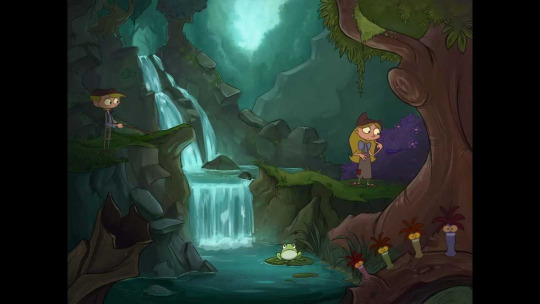
I first contacted the people who worked on the storybook's animation and that had either a gmail adress or a Tumblr. So far I have sent messages to Paco Vink, David Muchtar, Jelle Brunt and Sjan Weijers. So far, only David Muchtar answered me. Of the animation team, those I only couldn't reach Ruben Zaalberg (he has a LinkedIn but I am not on this website). I also sent a formal email to Anikey Studio via their official website - no answer so far.
I thought about contacting Lou Attia, the voice actor for the English version of the app, but couldn't find any way to do so.. If I still do not have in the future any answer, I will try contacting other members of the team. I do not expect any answer, but at least I would have tried!
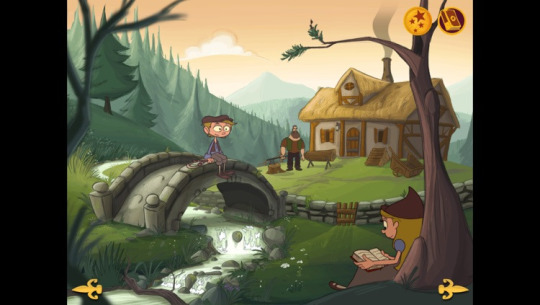
The good news is that, as I told you before, David Muchtar did answer me and we had a quite pleasant conversation!
Unfortunately, he confirmed that he had preserved nothing of the files, art or animation he worked with during his time on the "Epic Tales" project (in fact, he told me if I ever found anything, I should sent it back to him because he would like to see it one more time). So all he could offer me was his testimony and his memory (which was, also unfortunately, quite vague - since it had been twelve years). But it was already a very valuable set of information, and so far the most precious information outlet I could have!
I am not going to speak of the story details here, I will keep this for a different post, but here are some facts he could share with me (some which are just confirmations of what I posted about previously, others which are new):
David Muchtar was an intern at Anikey Studio when he worked on the project. As such he didn't have any overview or decision when it came to the story as a whole, he just, to quite him, "animated what was in front of him". There was a second intern of the Studio who worked on the project: Ruben Zaalberg, who was a classmate with Muchtar at the HKU. They both interned for eight months roughly at Anikey. It was Muchtar's first experience as an animator for a studio.
He is pretty sure Anikey Studio still has the files somewhere, but since they don't own the rights to them, they likely can't release them (but he can't confirm this).
Paul Hanraets was the creator and investor who made the project come to life in the first place. He was a businessman who owned a company called Gambitious - it was a crowdfunding platform meant to help independent game developers and publishers, by helping them get funding. "Epic Tales: Hansel and Gretel" was a personal project of his, a "side-project" in which he poured his own, personal money. And while he had planned to continue the "Epic Tales" line, the first game never made him enough continue to continue the project (despite being quite famous upon its release).
The story and the visual style of the interactive storybook were designed by both Paul Hanraets and Anikey Studio. Anikey was truly a small studio at the time, consisting only of two men (Albert't Hooft and Paco Vink) plus one freelance animator (Jelle Brunt, who notably worked on the Anikey short film "Fallin' Floyd".
One specific animation David Muchtar had to work onto was, in the tableau of the kids sitting in front of their house (I posted several screenshots of it), the squirrel - supposed to come out of a hole in the tree, and run on the branch. He had been given the background art and the squirrel concept art by Anikey Studio. His job was to create the animation, clean-up the art and do the colors. In the same scene he had to animate the characters of Hansel and Gretel, while the woodcutter was done by Ruben Zaalberg.
Outside of this specific example, David Muchtar worked on many different animations throughout the game - each animation he was handed was his sole and entire responsibility, apparently? So, in his own word, this made him act as a "key animator, inbetweener, cleanup animator and colorist". He did note that in the final product, it is his drawings, his animation, directly put into the app - with no other hand or influence modifying his work. And that such a thing is very rare for him, despite having been working as an animator for more than ten years now.
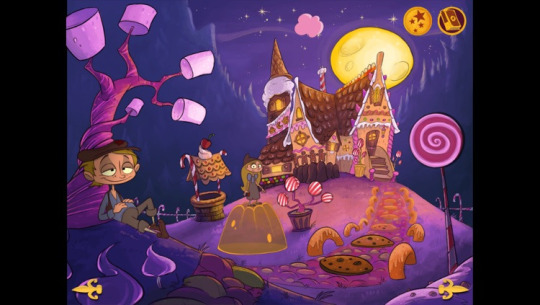
Beyond all this info, he did share with me some story details. While my posts about this lost media are not very popular, I did find a few testimonies of other people who crossed path with this application... However they range from "I saw a demo in a shop a long time ago but couldn't play it" to "I only played the storybook twice, and so I only recall one or two scenes". But, as it is with all serious research, it is not because a testimony is fragmentary that it is less valuable!
We are currently re-creating an enormous puzzle scattered throughout the world, and each piece, no matter how tiny, is important! In fact, this will be the object of my next series of posts. Given all I could collect, I will try to reconstruct the story and content of the animated storybook...
I will mention that I do believe the storybook was actually influenced by some specific cartoon works. Several reviewers described a "Disney-feeling" to this animation - and I hold the belief that the way the witch was vanquished (not though an oven, as the app was designed to be a light-hearted and more cartoony take on the story) is an homage or was inspired by Disney's "Babes in the Woods"...

That being said, I will already post here two precious resources for information about the changes performed to the Hansel and Gretel fairytale by the storybook.
Katie Bircher's review of the app for The Horn Book gives us a lot of insightful information as it highlights key differences and divergences with the original story:
A caveat: as the Kirkus review points out, the characters of Gretel and the children's father are "largely relegate[d]...to passive roles." In the father's case this passivity minimizes his complicity in the wicked stepmother's machinations, rendering him innocent. In Gretel's case, however, it makes her a mere tag-along to the story's star, "clever" Hansel. (And another thing ��� we're repeatedly told Hansel is clever, but his behavior isn't consistent with this characterization.) Most of the app's changes to the plot are innocuous, if unnecessary, but one change I find troubling is the revised denouement. Instead of Gretel saving the day by pushing the witch into her own oven, here Hansel defeats the witch alone. This version is more Hansel's story than that of Hansel and Gretel.
[... Here is a list of other elements unique to the app's story:]
Tiny, bad-tempered gnomes are ubiquitous in the illustrations and animations, but never mentioned in the text until they eat Hansel's breadcrumb trail.
After the children's wicked stepmother takes them deep into the forest, she gets lost there herself and is never seen again — although her complaining can still be heard.
Hansel shoots the witch with his slingshot, pitching her forward into her own cauldron, which propels her up the chimney and out of the house.
A garden full of modern-day sweets (e.g., fizzy lemonade, gummies, and cotton candy) surrounds the witch's house. The enchanted gummy animals are returned to their true forms after the witch's defeat. A formerly-gummy swan offers to fly the children home.
Hansel, much heavier after his ordeal, is magically restored to his previous skinny state.
I will complete this review by the Kirkus Reviews linked within the previous article, which does note a lack of "psychological melodrama" and notes:
These include grimacing monsters and surly gnomes popping into view, the evil stepmother’s Cockney-accented screeches and fragmentary ditties like a skeletal minstrel’s “Dinnertime dinnertime for the witch, / She will eat the little boy, she’s suuuuch aaaa….” That fortuitously interrupted last line, plus some eerie moments in the dark woods, may be more appreciated by sophisticated audiences. On the other hand, neither the witch nor the stepmother is definitively killed off, and the title screen offers a “Play Around” option that dispenses with the storyline entirely in favor of going to any screen to check out the interactive features.
If you ask me, I think we have enough dark Hansel and Gretel retellings around to allow us a light-hearted, goofier one... But that's just me!
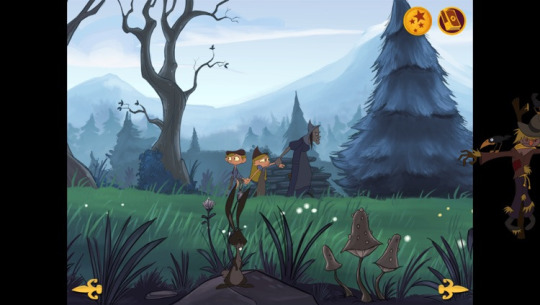
#lost media#hansel and gretel#epic tales hansel and gretel#hansel and gretel epic tales#epic tales#lost animation#traditional animation#hans en grietje#epic tales hans en grietje#app#interactive storybook#animated storybook#animation
8 notes
·
View notes
Text
So Anna's child verse is pretty versatile depending on the time period, so it's basically a little multiverse of different situations she'd be in.
So!! Here's the general child verse timeline (aka where and what Anna would be, as a child, in a specific time period):
16th Century, Parents Alive — Mainverse Anna, living in a secluded forest grotto with her parents and other dragonskins.
16th Century, Parents Deceased — Mainverse Anna, adopted by an old woodcutter and his wife.
17th Century, Parents Alive — Traveling with caravan of disguised dragonskins; her parents work as merchants.
17th Century, Parents Deceased — Ward of the local church. Kept under close surveillance due to rumors of her being a changeling child.
18th Century, Parents Alive — Assists her mother in her tailor shop; her mother makes expensive clothing for nobility.
18th Century, Parents Deceased — Ward/foster child to a well-off family. Essentially a plaything for their spoiled daughter because of her odd hair color.
19th Century, Parents Alive — Daughter of a wealthy couple who specializes in clothing and jewelry.
19th Century, Parents Deceased — Basically just Cosette from Les Mis lmao. An orphan hired by an innkeeper to care for the horses and livestock. She sleeps in the stable.
20th Century and Onward, Parents Alive — Daughter of a relatively wealthy couple. Her father is an "important businessman" with a strained relationship to his side of the family. She's never met them. Yet.
20th Century and Onward, Parents Deceased — In and out of the foster care system. Has not been adopted yet.
5 notes
·
View notes
Photo










Levi Strauss Day
They’re comfy. They last for years and years. They don’t require dry-cleaning or any other kind of special treatment. They’re perfect for a number of occasions, from a trip to the grocery store, to a walk in the park, to an evening at the pub, to a number of even semi-formal social occasions. They’re incredibly versatile, meaning they look good with pretty much everything, from t-shirts to smart blazers. In fact, you can’t imagine life without them at all.
What are we talking about? Jeans, of course! This iconic garment is more than deserving of it own holiday, as is Mr. Levi Strauss, a man without whom jeans as we know them might not exist at all.
“In the old days, people used to risk their lives in India or in the Americas in order to bring back products which now seem to us to have been of comically little worth” – Levi Strauss.
The History of Levi Strauss Day
Levi Strauss was a German-American businessman born in Bavaria on February 26th, 1829, who came to the United States with his family the mid-1800s when he was 18 years old. Strauss began as a dry goods wholesaler in San Francisco, California, where he sold various items such as clothing, bedding, bags and handkerchiefs to settlers, many of whom had arrived in California to take part in the gold rush. Needless to say, the hard physical labor required of the miners of the day and those building new railroads made it difficult for them to find clothing that would last for more than a few months without falling apart at the seams. One day in 1870, one of Strauss’ clients, a tailor named Jacob W. Davis was approached by a woman who needed a pair of exceptionally strong working pants for her husband, a woodcutter. Her request prompted Davis to make a pair of pants from the denim he’d bought at Strauss’ shop that he then strengthened with copper rivets to reinforce the stitching. Word of the new article of clothing and its endurance spread fast, and soon Davis was not able to keep up with the demand for his invention, nor did he have the resources to open a larger tailor shop or obtain a patent. Falling further and further behind and afraid someone else would steal his idea, Davis decided to ask for Strauss’ financial backing in the filing of a patent application. Strauss agreed, the patent was issued, the two men became business partners, and Levi Strauss & Co was born.
How to Celebrate Levi Strauss Day
Levi Strauss’ story is considered to be the quintessence of the “American Dream”, a belief that all men and women were created equal and that hard work, ambition and creativity are all that is needed to become successful, both financially and otherwise. Levi Strauss’ family was anything but wealthy, with his father making just enough money as a peddler to keep the family afloat until he died of tuberculosis, a tragedy that plunged the Strauss family into poverty. Regardless of any and all setbacks, however, Levi Strauss managed to make an enormous amount of money. Strauss was not the stereotype of a stingy, rich miser, however–far from it. Throughout his life, he made numerous donations to various orphanages and other charity organizations. That’s why a great way to celebrate this day would be to read the biography of Levi Strauss or any other man or woman who has achieved success through hard work and dedication, and then used his or her money and influences to help others.
Source
#San Francisco#Morro Bay#summer 2022#2017#original photography#USA#Freemark Abbey Winery#Las Vegas#Paradise#Sierra Nevada#travel#yes all of them are Levi's jeans shorts#levi's is my favorite jeans brand#vacation#landscape#cityscape#HQ#headquarters#Levi Strauss Day#LeviStraussDay#26 February 1829#birthday#Levi Strauss#anniversary#born#US history#Austrian history#California#Nevada
3 notes
·
View notes
Text
He stepped into the office, the back window a panorama of the city below it. The woodcutter's axe dripped crimson down its black blade, spotting the clean, white floors.
At the center of the office, right by the window, a man sat in a business suit, absent-mindedly flipping through a thick series of documents.
"Well, well, Xavier," The businessman said, "Taking a tree-killing tool to the Air Industry, aren't you so poetic?"
"I'm not here for the trees, O'Hare," Xavier said, lifting the axe, "I'm here for you. You sell lies, and I'm here to tear you down."
O'Hare cackled, and sat up from his desk, holding in his hand a remote. He pressed a button on it, and something rattled above them. Xavier looked up, only to see a glass box fall on top of him, connecting to a large tube reaching into the ceiling. Encased in the box, Xavier walked up the glass walls, and O'Hare stood on the other side, hands in his pockets and a smug look on his face.
"If you hate my air so much," O'Hare sighed, "Then I'll take it back."
The glass box then began to suck all the air out of it, turning the interior into a vacuum with Xavier inside. O'Hare cackled again, and turned away, his hubris wrapping around itself like a mobius strip. Soon, Xavier would be dead, suffocated, and this problem would just blow away like-
Crack!
O'Hare spun around, and saw the axe blade embedded into the wall of the box. Xavier ripped the blade out, and swung it again, the fracture along the wall expanding with each, powerful swing.
"How-how are you-"
The axe broke through the glass, shattering it into a thousand pieces. Xavier stepped through, walking towards him with the axe in hand.
"Oh, O'Hare. For all your brilliance you missed out on one, tiny detail. I. Don't. Breathe. Air."
O'Hare shuddered, stumbling and landing on the crisp, white floors of his office. He looked up at Xavier, raising his arms in some pitiful attempt to defend himself.
"Ple-please! I'll do anything! Anything!" O'Hare pleaded. Xavier lifted the axe high over his head.
"Then perish."
He swung down, and the white floors became splattered with red.
Finally, Big Air was defeated.
You and your friend have a breath-holding contest. You’re on day two now and are beginning to think breathing is a scam perpetrated by big air.
4K notes
·
View notes
Photo

Levi Strauss was a German-American businessman born in Bavaria on February 26th, 1829, who came to the United States with his family in the mid-1800s. Strauss began as a dry goods wholesaler in San Francisco, where he sold various items such as clothing, bedding, bags and handkerchiefs to settlers, many of whom had arrived in California to take part in the gold rush. Needless to say, the hard physical labor required of the miners of the day and those building new railroads, made it difficult for them to find clothing that would last for more than a few months without falling apart at the seams. One day in 1870, one of Strauss’ clients, a tailor named Jacob W. Davis, was approached by a woman who needed a pair of exceptionally strong working pants for her husband, a woodcutter. Her request prompted Davis to make a pair of pants from the denim he’d bought at Strauss’ shop that he then strengthened with copper rivets to reinforce the stitching. Word of the new article of clothing and its endurance spread fast, and soon Davis was not able to keep up with the demand for his invention, nor did he have the resources to open a larger tailor shop or obtain a patent. Falling further and further behind and afraid someone else would steal his idea, Davis decided to ask for Strauss’ financial backing in the filing of a patent application. Strauss agreed, the patent was issued, the two men became business partners, and Levi Strauss & Co was born. #LeviStraussDay #RacketOfTheDay #CustomMade #TennisRacket #breakthetie (em Levi's strauss) https://www.instagram.com/p/Cabz2mkgP6u/?utm_medium=tumblr
0 notes
Text
Producer as a Storyteller
We were all assigned a story to read and break down. I was given Hansel and Gretel. This story in particular was about a poor woodcutter who had two children with his first wife. He then re-married and the second wife wanted rid of the children and to take them to the forest to abandon them. The dad finally agreed with the step-mom that they should leave the children in the forest. Hansel made a trail of pebbles which they followed the trail home. The step-mom took them back into the woods the next day, this time Hansel made a trail using bread crumbs. However, the crumbs had been eaten by birds and couldn’t find their way back. They found a house made of candy and they started to eat the candy as they were hungry. An old lady—a witch came out of the house and invited them and fed them all the food they wanted. She told Gretel her plans. The witch was forced to fetch the water to cook Hansel as Gretel wasn’t putting any weight on so the witch didn’t want to eat her. Gretel was made to test the oven temperature with intentions to trick the witch and to push the witch into the oven. The witch is now dead. Hansel, Gretel and their dad now live a rich happy life. The step-mom is no longer seen.
How it relates to the modern day:
· A story that shows sibling love and loyalty
· A family that have very little money, the children go out and find a way to support their family.
· The step-mom is an example of step-parents in the modern day. Children typically hate when their parents split and remarry, there’s always an evil step-parent.
· Child neglect
· Stranger Danger
· Kidnap
Morals of the story:
· Protect and love – always protect each other.
· Hard work
· Intellect will make you rich
· Be careful who you trust
· Be smart to survive
We were given a chance to switch stories. I changed to The Cinderella Story.
Idea generating:
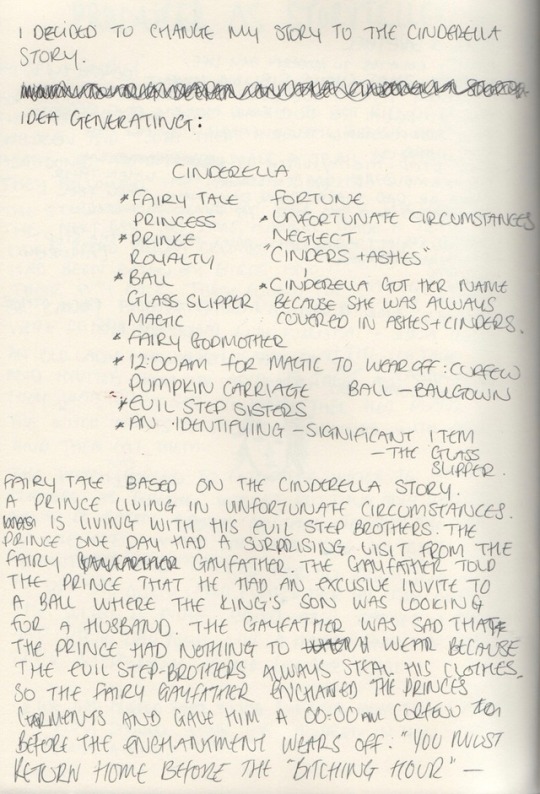
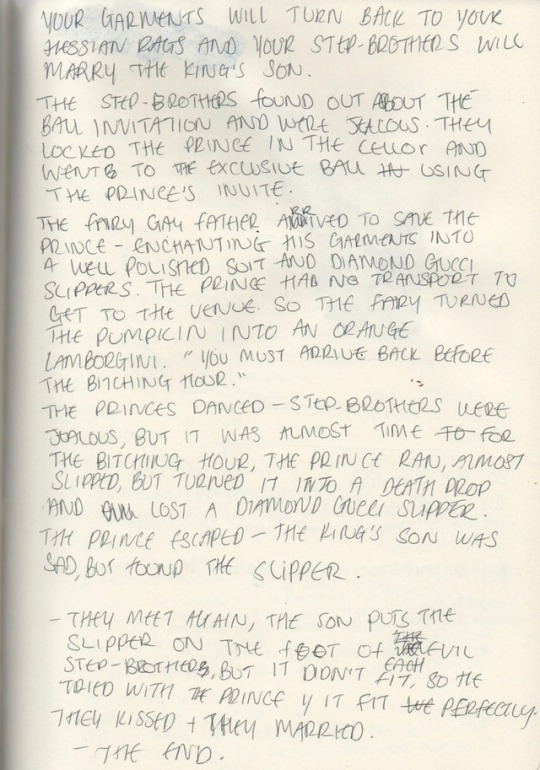
Fairy tale based on The Cinderella Story. A prince living in unfortunate circumstances. Has 2 evil step brothers. The Prince received a VIP invite to a ball from another Prince. He had a surprising visit from a Fairy Gayfather. The Fairy was sad that the Prince didn’t have any clothes to go to the ball in, so he promised to enchant the Prince’s garments on the night of the ball so that he had something to wear. However, magic wears off and there will be a curfew. The step-brothers found out about the ball and were jealous. They wanted to marry the other Prince. They found the invitation and locked the Prince in the basement so he couldn’t go. The step-brothers got ready and went instead. The Fair Gayfather arrived to save the night. Helped the Prince to escape and enchanted his garments. The curfew was set for 00:00. The princes danced all night and the young prince had to run before his garments changed back to the rags. He left his Gucci Glass Slipper behind. The other prince found it and searched for him for days. He found the Prince, they married and lived happily ever after.


I decided that this story wasn’t modern enough with the changes we have experienced over the past 10 years. So, I decided to do a digging deeper exercise.
https://www.tate.org.uk/art/artworks/cahun-untitled-p79320
It seems like Cinderella and her prince had too much fun. Her garments and shoes are on the stairs, leading to the bedroom.
https://www.tate.org.uk/art/artworks/althamer-self-portrait-as-a-businessman-t11913
An image of significant items a businessman uses every day.
Suit, tie, shoes, newspaper, phone, briefcase and passport.
https://www.itsnicethat.com/articles/frieze-london-masters-2017-round-up-art-051017
“Sex work: Feminist Art & Radical Politics” Curated by Alison M. Gingeras. “Focus on explicit sexual iconography combined with radical political agency”. Highlights include work from Penny Slinger, Richard Saltoun, Betty Tompkins and Dorothy Iannone, whose vivid paintings tell intricate stories in vivid colours.
Can you find any online articles and books that relate to your keywords?
https://www.dailymail.co.uk/news/article-45763/Youngsters-addicted-mobile-phones.html
https://www.dailymail.co.uk/femail/article-3134575/Cinderella-dances-prince-loses-glass-slipper-stunning-film-tells-classic-fairy-tale-eyes.html
https://www.amazon.co.uk/iDisorder-Understanding-Obsession-Technology-Overcoming/dp/0230117570
https://www.goodreads.com/book/show/14475327-significant-objects
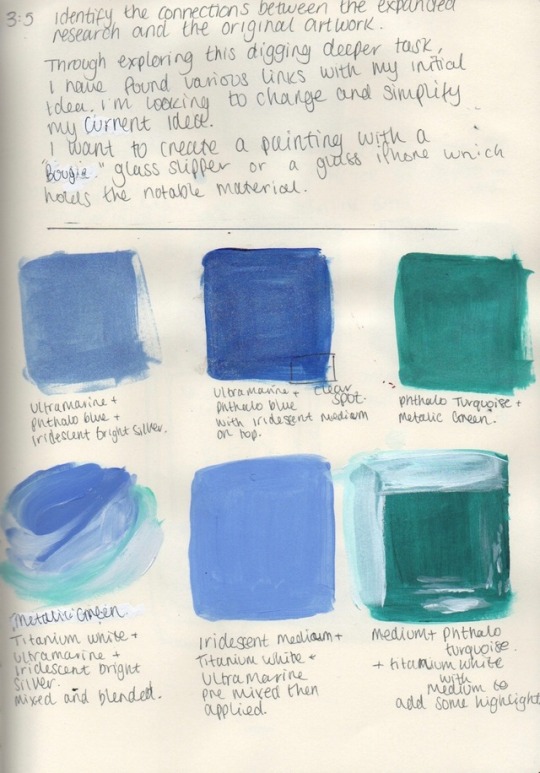
Through exploring this digging deeper, I have found various links with my initial idea. I’m looking to change and simplify my current idea. I want to create a painting of a designer glass slipper or a glass iPhone with Cinderella influences.
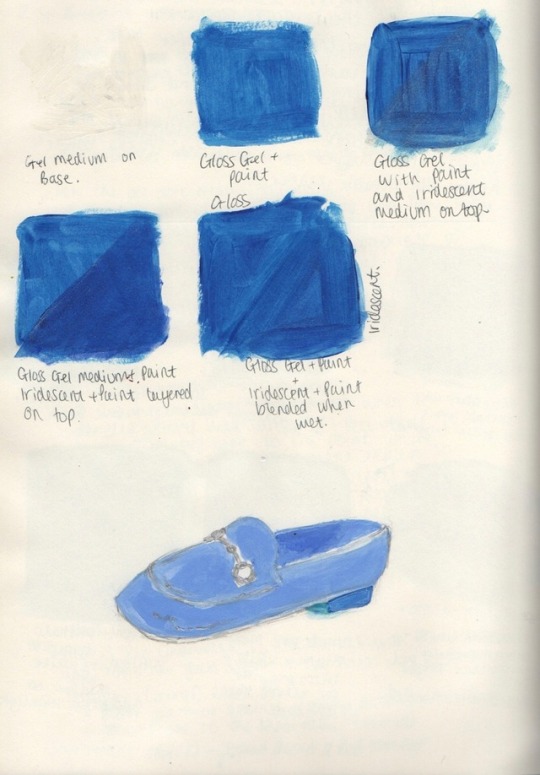
I started to swatch some colours and using mediums such as Gloss Gel Medium and Iridescent Medium by Liquitex. I really think that the Iridescent Medium worked so well to achieve an almost glass finish which relates perfectly to the glass slipper from the Cinderella story.
Thinking more about modern technology.
Mobile Phones – Dating apps – tinder – New developed idea:
Cinderella is a dating app. A prince looking for his true love on Cinderella after dancing all night with a handsome prince at the ball.
Sculpture of a mobile phone with the ‘Cinderella App’.
Unfortunately, when making this… It broke in half and I had no time to fix this. So, I had to resort to making a painting of the app. Here’s what I came up with.
This project was too short for how creative I could have gotten. I would have loved to create at least an A1 painting with more of a storyline rather than having to think carefully about my time management. I did however enjoy practising with Liquitex mediums to achieve different paint outcomes.
To come to an end with this project, we were split up into groups of 6 to criticise each other’s work. The rules were that for 10 minutes the person who was getting their work reviewed, they couldn’t speak or answer questions – then after they had 5 minutes to talk about what their work was exactly about.
Oliver’s review:

We guessed his art work to be from the story Red Riding Hood. This drawing was out of composition and had too much white on the one side of the drawing. However, the use of text worked really well, “Don’t you trust me?” in the colour red. We assumed that the text was in red because the story is called Red Riding Hood, there’s actually a deeper meaning as to why this was the colour red (to be explained later). The rest of the drawing is in black and white which can be quite affective however, because the character is wearing a hoodie sweater, it would be cool to see if she’s wearing a red hooded sweater and to have the rest of the drawing in black and white. Because the character is on their phone having a conversation over text message, I felt that the text “Don’t you trust me?” should be a bubble coming from the mobile phone so it looks more of a texting conversation, rather than a caption of the image.
The actual meaning behind this was:
Phones are used too much and it’s an example of the dangers behind the screen. People aren’t educated enough about the dangers of the internet; catfishes, paedophiles and other dangerous things. Red Riding Hood believes she’s texting her nan, but is actually the wolf who wants her to come over. Red Riding Hood was being led to her nan’s home where she will be killed. The red text was to resemble Red Riding Hood, but mostly blood and about her being killed by the wolf.
In my opinion, I liked the idea of the work, but there were so many unfinished things about it which could be easily changed. The composition of the drawing could easily be changed by finishing some parts where the anatomy has been missed out, whether Oliver draws an outline, but not to completely polish the section, but to show an impression that Red Riding Hood’s waist is there. This would also add to the story by saying that It’s a metaphor of Red being killed and being erased from the world.
Amber’s Review:

Amber created a beautiful delicate acrylic painting which we thought was also Red Riding Hood. She really researched every detail in this painting as it was obvious to us that there were Celtic influences (the boarder around the painting and the clothing on the characters). We could easily guess that the location of the work was either Scotland or Ireland. The boarder around the painting also gave a tarot card aesthetic which was quite nice to see as I have been looking into tarot cards in some of my projects. When looking at her painting, the first thing I looked at and was mesmerised by is the bear in the clouds. It was really well done and captured the audience’s attention. I see bear as a spirit animal that lives in the clouds to protect the person who wears its amulet of protection.
She shown her inspiration of the piece so clearly:
· Disney Brave
· Celtic history
· Protection and bravery
· Strong warriors
I really liked the small details of this art work too, the image has a great composition and really nice textures: the hair, skin, clothing and the vegetation. There was great use of vanishing point too. The main wolf is being haunted but is still showing signs of strength and appeared to be the alpha.
The actual story and details:
Original story are Snow White and Rose Red.
Snow White and Rose Red are dangerous ruthless killers. Amber didn’t want to create perfectly groomed characters with the typical female stereotypes and wanted to create them into fierce characters. She explained how she searched into her own family history and her surname. It leads back to Ireland and she related this into her painting. Her family history ‘O’Sullivan’ where she found out that they had their own song, their own shield and family crest. The most interesting part is that they had an omen which is a bear: That’s why there’s a bear in the clouds. This shows hidden symbolism in her work which was nice to learn. She wanted the main wolf to be a boar because that was her family crest. She said that she didn’t paint a boar because she didn’t have any references to paint one. However, she could have found references on the internet which could have made this more relatable.
My work being reviewed:
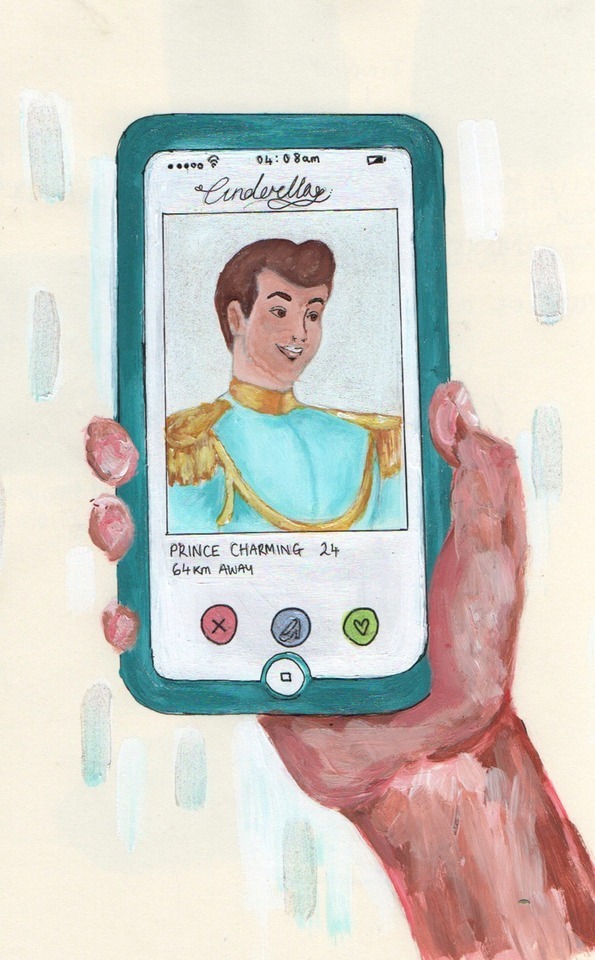
· Cinderella apparently feeling sorry for herself, so she resulted to Tinder at 04:08am to find a midnight hook up.
· The time on the phone is because the prince is trying to find their date from the ball and didn’t take their phone number so they’re trying to find them on the dating app.
· To express that people are so caught up with finding their own Prince Charming on the internet.
· Photos are easily photoshopped.
· Classical aesthetics
· Clear inspiration
· Clear definition between the hand and the phone.
· Some proportions are a bit off.
· The small details work great – the Iridescent Medium
· Time was the enemy in this piece as it was evident that I didn’t have much time to do exactly what was planned.
· A background to give a sense of environment
· The marks in the back ground is rain?
The actual story/details:
Cinderella is a LGBTQ+ dating app where the user can find their own true love with people who have the same intentions. The Prince had left the ball without leaving his number with his date. His date (another Prince) was searching for his true love on the Cinderella dating app at the early hours of the morning. The rain in the back ground is a metaphor to express that the Prince is sad that the other Prince didn’t leave his number.
Key features of this painting:
· The glass slipper has replaced the super like, which the guys had mentioned was a really nice detail. Brings relevance from the story and the inspiration from Tinder.
· The use of the Iridescent Medium which shows influences from the glass slipper.
· The colour of the smartphone brings inspiration from Cinderella’s Ball Gown and Glass Slipper.
· Why the Prince Charming on the app screen has a blurred looking face is because in today’s modern culture, people are using photoshop to make themselves look blemish free and beautiful.
I really enjoyed this project. However, it is sad that there was such a limited time frame which didn’t allow me to get into greater details with a painting. I would love to have made a much bigger painting – scenery and more story; experimenting with other paints such as oil paints and layering different paints – acrylic and oils.
0 notes
Text
some KuroHina AUs, feel free to use any of them
AU where Kuroo is a lazy cat spirit that inhabits a temple soon to be torn down, and when Hinata visits said temple, and touches his statue in curiosity, Kuroo takes the chance to bond to him and follow him home to keep from disappearing just yet – then proceeds to make himself an utter pest to Hinata and the household.
AU where Kuroo is a baseball star and Hinata is a rookie baseball player mentoring under him, or, alternatively, a reporter tasked with interviewing him.
AU where Kuroo is a poor fisherman who meets a merman named Shouyou, who’s playful and friendly and has scales that shine like the sun. He helps catch fish for him for nothing in return except talking to him, and Kuroo thinks he might be in love.
AU where Hinata is an Italian or Irish missionary who arrives in 1500s or early 1600s Japan, and Kuroo is a daimyo or samurai who takes him in due to the worsening political climate.
Alternatively, AU where Hinata is a foreign missionary, businessman, or sailor who arrives in post-Meiji Restoration Japan, and Kuroo is a Japanese businessman from a former Samurai family that takes a liking to him.
AU/post-canon where Hinata takes a trip to Tokyo to meet up with Kenma, who then fails to show up at the bar he told Hinata to wait at. Kuroo’s the bartender there, having taken the job to help pay for college, and when he and Hinata realize who the other is Kuroo explains that Kenma suddenly fell sick and couldn’t make it. He offers to show Hinata around Tokyo for a day or two until Kenma’s well again, and Hinata accepts.
Steampunk/fantasy AU where Kuroo is an air pirate. I can’t think of any more for this, but roguish air pirate Kuroo tho
AU where Kuroo is a mountain shepherd who finds Hinata, who ran away from home to avoid a forced marriage, wandering the hills, and shelters him, though initially reluctantly.
road trip AU
road trip gone wrong/stranded and have to get home AU
(Based on this post, and on a conversation with Kuroohina) AU where Kuroo and Bokuto are best buddies and drug dealers specializing in weed and other light drugs, who wear atrocious clothes and work from a base that fronts as a flower shop. A well-dressed ginger-haired boy named Hinata comes in one day and Kuroo’s immediately smitten, and gives him flowers on the house. They start dating and Kuroo is amazed at how such a perfect and always stylishly dressed boy is dating his sleazy self, but worries about how this innocent ball of sunshine of a boyfriend would react if he found out he was a drug dealer, and goes to increasingly outlandish attempts to hide the truth. Eventually Hinata finds out anyway, and is unfazed; and Kuroo’s shocked, but it turns out — Hinata’s a drug lord, specializing in meth and cocaine. And he wants to team up with him. It’s a crackfic.
MUSICAL AU. But Fiddler on the Roof, Rodgers’ & Hammerstein’s Cinderella/No Strings, Singing in the Rain old-fashioned type musical, not Phantom of the Opera, Book of Mormon, Into the Woods modern type musical.
Alternatively or more specifically, The King and I AU
Alternative to Alternatively: Annie Get Your Gun AU. “Anything you can do I can do better, I can do anything better than you!” “No you can’t!” “Yes I can!” “No You Can’t!” “Yes I can, yes I can!”
AU where Hinata is a superhero who believes in truth, justice and world peace, and Kuroo is a cynical supervillain who may not be as evil and selfish as he seemed at first, and tries to appear, but is definitely as obnoxious and annoying, maybe even worse.
AU where Kuroo works at an amusement park and finds a crying Hinata, who was stood up for a date (the second or third time it’s happened now actually). Kuroo offers to be his replacement date, and takes him on all the rides and games over the next few days during his breaks.
AU where they’re both artists. Painters, sculptors, photographers, some combination thereof, or something else, whatever floats your boat.
platonic KuroHina AU where Kuroo is a conductor on a train or tramway that Hinata takes to and from school every day, and Kuroo watches him grow up over the years.
AU where they’re both hired, as stars or extras, to star in an epic historical drama, and have to deal with the grueling, intensive filming sessions required.
AU where Kuroo is a server in an upscale restaurant and has to show new hire Hinata the ropes
AU where Kuroo is an avant-garde composer in the early-/mid-20th century trying to push the limits of classical music, and Hinata is a young violinist who becomes both the performer and the muse of his works, helping him achieve a new and startling brilliancy, while a new passion grows between the two, both for music and for each other.
AU where Kuroo is a film stuntman and Hinata is a camera worker
AU where Kuroo is a con artist and stage musician. He finds a tattered old book of spells and buys it for inspiration for his shows, but when he reads one of the chants aloud it summons into his bedroom a fiery-haired demon named Hinata. Feeling insulted when told he was summoned by accident, the djinn tries to leave, but finds he can’t, because whoops, they’re bound together by the summoning. Now Kuroo has to share a crummy flat with a rambunctious demon who’s apparently ancient but looks like a teenager and has the energy of a five-year-old, and who’s constantly nagging him to go out and see the world after being cooped up in the Other place for centuries. But then again the djinn is pretty powerful, and he insists he can grant Kuroo anything he wants. (And after being single for years, he can’t really complain at company that wears such thin, gauzy fabrics for clothes that leave little to the imagination)
1920s/1930s Bootlegger AU
AU where both are show dancers who team up together after their respective dance partners bail on them.
AU where Kuroo is a woodcutter, and is about to cut a cherry tree down one day when a voice begs him not to cut down their tree. Out pops from the trunk forest nymph Hinata, and they become friends in the lonely forest where they both live.
11 notes
·
View notes
Photo


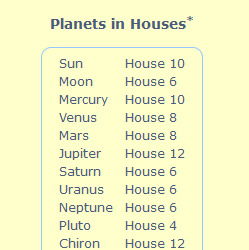
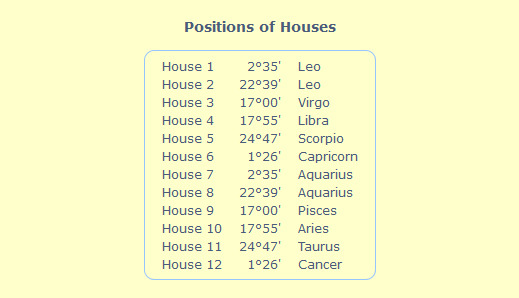


Birth Chart Calculator
Sun 26°28' Aries, in House X
Sun Aspects
Sun square Saturn orb +1°23'
Sun sextile Mars orb -0°24'
Sun semi-square Venus orb +0°35' Planets: Sun
The Sun represents vitality, individuality, will-power and creative energy and honours. For a woman, it also represents her father, and later her husband. The Sun is one of the most important symbols in the birth chart, as much as the Ascendant, then the Moon (a bit less for a man), the ruler of the Ascendant and the fast-moving planets.
It's element is fire; it is hot and dry, it governs Leo, is in exaltation in Aries and is in analogy with the heart. It represents the boss, authority, beside the father and the husband ; the age of the Sun goes from 20 years old to about 40, following the Venus age when one is aware of his seductive power.
Temperament : Bilious
Characterology : Emotive, Active, Secondary, passionate type.
Sun in Aries
Your entourage is amazed by your energy, your courage and your boldness. Your reactions are quick, even instantaneous. Your enthusiasm prompts you to follow your natural impulses, even though you are not aware of all the consequences of your actions. Above all, you want to live each moment intensely, without fearing the future. Your enterprising spirit is supported by an acute sense of confrontation. Present! This is Aries answering the call. Any call, provided that there is some degree of new-ness or some challenge. If Aries’ dynamism and enterprising spirit are underlined, it is because the sign is more inclined to commit itself in the present and to start from scratch. This ability to take action on the spot in response to any stimulation also applies to the area of your relationships: you say outloud what you deem necessary to say, even if it means foolishly upsetting several persons. It is black or white, yes or no… often without balance! Beginning and undertaking are situations where you feel that you are in your element. Your qualities can also be expressed when you are bogged down in inextricable and complicated relationships: you know how to simplify things but you should beware not to do so in a caricatured manner.
Sun in House X
With the Sun in the 10th House, you pay high attention to your social image, you try to have your capacities acknowledged, and you want to arouse respect and admiration. In a word, you want to find your place in the sun. It is not that easy... Whereas successes increase your enthusiasm and your efficiency tenfold, failures may get you disheartened. Therefore, it is preferable to make your task easier, and to reinforce your self-confidence which may be weak. Your fulfillment depends on your social success, and on getting other people's recognition.
Sun Dominant
If the Sun is part of your natal chart's planetary dominants, in astrology, you are said to be a Solarian: you loathe pettiness and Machiavellian maneuver, and you are fond of natural nobleness as well as of direct and honest attitudes. You endeavor to get out of muddled or dark situations as quickly as possible. Your need for transparency may lead you to make cut-and-dried judgments such as yes or no, and black or white. However, your honesty commands your entourage's consideration. At times, you come across as authoritarian. It is true that you never want to be thought of the notable absentee, and that you manage to make people pay attention to you, as well as to your plans and your assessments. To this end, the Solarian sometimes develops a great talent for placing himself under the spotlight without missing a single opportunity to arouse interest. Some other Solarians, although more discreet, still manage to be the focus of any debate, even in situations of exclusion. It is your way of being present even though you are actually not there... More than other people, you appreciate the esteem extended to you. It is useless to cheat with you, since in all areas you consider establishing enduring relationships only with those who love you, admire you, respect you, or express some degree of affection to you. Your will to straighten out your inter-personal relationships is your strength and sometimes, your Achilles' heel. You cannot achieve anything behind the scenes. Therefore, your comportment is marked with heroism, and your stands are devoid of ambiguity, in the sense that your commitments are unfailing, and your rebuffs, final.
Interpretation of the 26° Aries symbolic degree "A man who stumbles over a stone is about to fall near a dragon watching him." (Janduz version)
Inventive, non-conformist, and obstinate character. One does not share the ideas prevailing in one's social background and believes that obsolete traditions need to be reformed. After having reached the peak of one's career, one is threatened by a reversal of fortune which can be overcome after many years of hard work and much courage. However, on the image, the man has not fallen down yet, and the dragon, which symbolises the guardian of treasures, indicates that total ruin can be avoided if one displays wisdom and persistence. If this degree is on the Ascendant and in conjunction with Mars and the Moon, there is a risk of violent death or serious eye condition. This degree also portends family estrangement and loss of traditions.
N.B.: symbolic degrees belong to a branch of fatalistic astrology. Their interpretation must be regarded with the utmost caution, especially given the fact that different authors give different meanings to symbolic degrees. This is the reason why they are not included in our Astrotheme reports.
Midheaven 17°55' Aries Midheaven or House X
The Tenth House still called the Midheaven, is the highest point amidst the houses, at the top of the chart, in the South, and relates to destiny in general and career (and not daily work as meant by the Sixth House). The Midheaven represents our achievements and goals in the social sphere, our social position in society, and becomes more and more important as we get older. It is in analogy with Capricorn and Saturn. The Tenth House is the most important angular house along with the Ascendant.
Midheaven in Aries
To build everything, to demolish everything, and then, to rebuild even better. Incapacity to settle, constant thirst for revival, dynamism, your independence: all these factors contribute to turn your destiny into a roller coaster, but this does not really upset you since the most important thing for you is that you never get bored and that you can use up all your energy. The following occupations may suit you very well, owing to their risky and challenging nature: policeman/woman, professional athlete, corporate manager, prosecutor, lobbyist, car race driver, stunt pilot, security guard, fireman, steelworker, woodcutter, machinist, butcher, businessman/woman.
Interpretation of the 17° Aries symbolic degree "A man and a woman shake hands affectionately. He touches her shoulder in a gesture of friendship." (Janduz version)
Kind, helpful, and honest character. Sincere feelings of devotion, peace, and harmony prevail within the family, as well as in the workplace among colleagues, employers, and employees. Success is nice and steady, though not outstanding. A female figure plays an instrumental role in enhancing one's social status.
Fortune 14°49' Aries, in House IX Part of Fortune
The Part of Fortune is an ancient concept, used by Ptolemy and other astrologers before him. Firstly, it has nothing to do with fortune! In modern astrology, it is actually used to enhance a planet or angle when in close conjunction with it: it thus amplifies the meaning associated to the point affected by its presence. It is calculated in the following way:
Part of Fortune = AS + Moon - Sun (it is the Moons position when the Sun rises)
The classical Part of Fortune, of which the calculus method is unchanged whether in a diurnal or nocturnal chart, is usually distinguished from the diurnal/nocturnal Part of Fortune which is calculated by the formula AS + Sun - Moon for a nocturnal chart, and AS + Moon - Sun in a diurnal chart.
We currently use the latter formula for our astrological programs.
Interpretation of the 14° Aries symbolic degree "A footbridge collapses under a man who falls into the river and struggles against the stream." (Janduz version)
Loyal and gullible character prone to misjudgments. One often misplaces one's trust and overestimates one's ability to evaluate people's honesty. Speculations are doomed to failure and bring about serious reversals of fortune. It is necessary to learn to know oneself, to accurately assess one's strength, and to be extremely careful in business and in the selection of partners. Should the natal chart concur, this degree warns against travels across the sea and all activities involving water.
Vesta 8°31' Aries, in House IX Asteroids: Vesta
Vesta is rarely used and brings the ability to efficiently devote oneself to a cause.
Interpretation of the 8° Aries symbolic degree "A man stands on a high balcony in a haughty attitude, with folded arms and upright head. He proudly looks at the city which spreads at his feet." (Janduz version)
Courageous, self-confident, and clever character. One makes a loyal friend or a formidable foe that is to be reckoned with. One does not shirk from dangers and tackles all difficult situations with self-control and bravery. The major downside is that one is often the victim of one's own pride, and that one is reluctant to ask for help. In the professional area, one achieves success thanks to one's excellent strategy and disregard for danger. If one obtains a position of power, one demonstrates a sharp sense of justice and always acknowledges people's talents.
Venus 10°52' Pisces, in House VIII
Venus Aspects
Venus sextile Uranus orb +1°16'
Moon sextile Venus orb +2°10'
Sun semi-square Venus orb +0°35'
Venus trine Pluto orb -6°05'
Venus semi-square Saturn orb +0°47'
Venus trine Jupiter orb -6°08'
Venus sextile Neptune orb -3°42'
Mercury sextile Venus orb +4°31' Planets: Venus
Venus represents the way one loves, relationships, sharing, affectivity, seductive ability. For men, she also corresponds to the kind of woman he's attracted to (but not especially in marriage which is more symbolized by the Moon, Venus is the lover and not the wife). Her element is the Air, she is moist, rules Taurus and Libra, is in exaltation in Pisces and is in analogy with the kidneys, the venous system, the bladder, the neck.
She represents the artists, tradesmen, occupations linked to beauty and charm; the age of Venus goes from 15 to about 25 years old.
Temperament : Sanguine and Lymphatic
Characterology : Emotive, non Active and Primary type or Emotive, non Active and Secondary type.
Venus in Pisces
Venus describes your affective life. On the day of your birth, she is found in Pisces. Your emotionalism is very strong and very unusual. You have your own manner to experience your emotions and your sensations, in an atmosphere that may be odd, you complicate your amorous life… and this is part of your charm, at the same time. On the chessboard of your sentimental life, quite strange games enfold. Your affectivity is subtle, fabulous and unusual: love reinvents everything and anything becomes possible when your heart is sincere. You dream of a complete fusion and of giving yourself totally. No rules, no moral or social code is more important than the feeling of shared passion and than living for your partner. Your affective life is complex, sometimes mysterious: you don’t know why you love, or why you don’t love anymore… Your sentimental life obeys a different logic than that of the external world. Love is elusive and fragile. Nothing is easier than to destroy a feeling and to forget a passion. Your sensitivity responds to an unknown call, a strange signal. Therefore, you may shift from intense and absolute feelings to cruel indifference. Although you don’t know why, you are being transformed. The most difficult thing is to love a real being and not a shadow. You give yourself to persons who can understand and respect the fragile realm of your affectivity.
Venus in House VIII
Venus expresses her characteristics through the 8th House values. You leave to other people peaceful love stories, and smooth adventures devoid of passion and tears. Your affectivity is well-adapted to crises, thrills, wounds, and healings. It is probable that, more or less consciously, you create some degree of tension within your couple's life. Love grows on contrasts, transformations, and self-questionings. Your ideal? To die out of love! Your sexual drive is powerful and demanding.
Venus Dominant
If Venus is part of your natal chart's planetary dominants, in astrology, you are said to be a Venusian: you are a sensual and emotional person particularly receptive to the natural likes and dislikes aroused by your contact with people. You are prone to frequent instinctive aversions and true passions which are exclusively driven by the feeling of love. The heart has its reasons which Reason knows nothing of... Your balance is based on the richness of your affective life. Without love, the Venusian is resourceless, lost, and deprived of any reason for living. You have an obvious and strong will to charm and to arouse the attachments without which you cannot properly function. Every area of your life is thus marked by your affectivity. The danger is that you may "be taken in" by charm. In such cases, you would prefer to keep your emotions under better control. Thus, hyper-sensitivity has its own inconveniences. Nevertheless, better than anyone else, you know how to play with feelings and attractions. Although you are sometimes caught in the traps of an over sensitive emotionalism, feelings remain your best assets in many circumstances. There is another aspect to the Venusian dominant. According to the Tradition, this planet rules the Arts, and you are endowed with some degree of artistic dispositions, ranging from good to excellent.
Interpretation of the 10° Pisces symbolic degree "A man and a woman reclining on a Roman bed cheerfully partake wine and fruits." (Janduz version)
Sensual, fickle, and impulsive character overindulging in sensuality and the pleasures of the table, shamelessly. One becomes quickly infatuated and gets bored as rapidly. Constantly going from one partner to another only brings about increasing frustrations. One must understand the difference between sex and love, and that the former is most unlikely to last forever. If one does not pull oneself together, some day, one may wake up, in poor health, to find out that years have gone by, and that one is left with a meaningless life. Although Pisces is considered a mute sign, this degree indicates that gossips cause serious troubles and that bad reputation threatens men and women alike.
Mars 26°52' Aquarius, in House VIII
Mars Aspects
Sun sextile Mars orb -0°24'
Mars trine Jupiter orb +7°51' Planets: Mars
Mars represents the desire for action and physical energy, sexuality, strength. For a woman, Mars corresponds to the kind of man she's attracted to (but not especially in marriage which is rather symbolized by the Sun, Mars is the lover, not the husband). Fire is its element, it is hot and dry, and it rules Aries and Scorpio (along with Pluto), is in exaltation with Capricorn and is in analogy with the muscles and the spleen.
It represents the soldiers, sportsmen, warriors, surgeons, blacksmiths... ; the age of Mars goes from 42 to 50 years old.
Temperament : Bilious
Characterology : Emotive, Active, Primary type. It is a Choleric.
Mars in Aquarius
The planet Mars indicates how you react to life concrete stimulations. It also describes your fighting spirit, your abilities to stand for yourself and to take action. With Mars in Aquarius, freedom of action is indispensable. Constraints are not part of your reality. You are open to the world, to all types of societies and to human matters in general. You fight for individual freedom and for the respect of all forms of expression. You do not tolerate intolerance! Your struggles involve collective, even universal contexts. Defending great causes is more exciting than coping with daily chores and you handle unforeseen events to the best of your abilities. But should the situation get stuck in a rut, you quickly tire. Your dynamism needs new-ness to show its worth. Your assets lie in your capacity for innovation and your ability to find original solutions to concrete life problems.
Mars in House VIII
With Mars in the 8th House, you seem to be meant for confrontations and crises. This configuration predisposes to challenges and heroic actions. Struggles may go as far as self-sacrifice, which may involve your interests, and in pathological cases, your own life. The Tradition mentions psychic powers and an inner magnetism on which will power has little control... Passion. You are fascinated by romantic relationships where love and hate are entangled. Female Black Widow, a species of spider, kills the male after love.
Mars Dominant
If Mars is part of your natal chart's planetary dominants, in astrology, you are said to be a Marsian: in your hand-to-hand struggle for life, you demonstrate an acute and active sense of confrontation with the world, with other people, and with your own destiny. You need to take action and to fight for your projects and your desires. You perceive all situations with deep intensity, and you react to the here and now without bothering to step back in order to ensure that events are under your control. You take up challenges with excessive foolhardiness as a consequence of your impulsiveness. However, better than anyone else, you know how to mobilize your resources in case of crisis. You take action whenever it is necessary to do so, and you are present in a timely manner. With Mars, your attitudes are dictated by the realities of the moment, by your emotions, and by everything which proved to have worked in the past. When this dominant is not well integrated, it may bring about an aggressive or impulsive behavior. Therefore, you must learn to control your hyper-sensitivity and your fits of temper. You are also endowed with Marsian qualities: the fighting spirit and the taste for duel without which one may find oneself overwhelmed by events. When this willpower is well channeled, its precious energy enables to cope with all sorts of contingencies. There are a thousand ways to win, and a thousand challenges to take up with the enthusiasm and the dynamism which make life so worthy. A certain idea of life which is wild, passionate, and in tune with events.
Interpretation of the 26° Aquarius symbolic degree "In a park surrounded by high walls, an imposing mansion has its the gate wide open." (Janduz version)
Sociable, simple, and benevolent character. One achieves success and wealth in real estate, trade, or industrial companies. Without ostentation, one enjoys a happy family life surrounded by numerous loyal and grateful friends.
True North Node 13°14' Я Aquarius North Node
The North Node (True Node here) represents the goals that must be achieved during life, in the karmic sense according to some traditions. Its position in house indicates in what field an effort is necessary in order to evolve. The North Node is often called the Dragon's head, it is usually considered beneficial, a bit like Jupiter with the planets. The Lunar nodes are fictional points and not actual heavenly bodies: they are the intersections of the Moon with the Ecliptic (the path made by the Sun in its orbit as seen from the Earth). The axis of the Lunar nodes moves 19 degrees each year, namely a bit more than three minutes each day.
The South Node is diametrically opposed to the North Node, therefore it faces it (it's not drawn here, it's the same symbol but upside down). It symbolizes what has already been achieved or acquired, in a karmic sense: it's the past from which it's advised to move on in order to progress. The South Node is rather negative, of a Saturnian nature: the experience through suffering.
Interpretation of the 13° Aquarius symbolic degree "A man stands in front of a broken bridge and a raging torrent." (Janduz version)
Courageous, wise, and helpful character. One is used to stand up for oneself since childhood, and one has thus developed great resourcefulness and self-sufficiency. Owing to one's wisdom, one attracts many genuine friends. This degree indicates a possible accident affecting the limbs and limiting the mobility, or a reversal of fortune caused by unpredictable phenomena such as flood, earthquake, or war. In such extreme circumstances, wealthy and grateful friends prove reliable and readily offer their support.
Mean North Node 12°52' Я Aquarius, in House VII North Node
The North Node (True Node here) represents the goals that must be achieved during life, in the karmic sense according to some traditions. Its position in house indicates in what field an effort is necessary in order to evolve. The North Node is often called the Dragon's head, it is usually considered beneficial, a bit like Jupiter with the planets. The Lunar nodes are fictional points and not actual heavenly bodies: they are the intersections of the Moon with the Ecliptic (the path made by the Sun in its orbit as seen from the Earth). The axis of the Lunar nodes moves 19 degrees each year, namely a bit more than three minutes each day.
The South Node is diametrically opposed to the North Node, therefore it faces it (it's not drawn here, it's the same symbol but upside down). It symbolizes what has already been achieved or acquired, in a karmic sense: it's the past from which it's advised to move on in order to progress. The South Node is rather negative, of a Saturnian nature: the experience through suffering.
Interpretation of the 12° Aquarius symbolic degree "An infuriated lion struggles against the bars of its cage." (Janduz version)
Ambitious, independent, and fiery character. It is indispensable to give up vengeful projects and to ensure that one's authority is not misused, lest all kinds of disastrous events and setbacks crop up. In a figurative sense, this degree indicates that one may be kept in prison by one's rebellious and anarchistic tendencies.
Saturn 25°04' Capricorn, in House VI
Saturn Aspects
Sun square Saturn orb +1°23'
Venus semi-square Saturn orb +0°47'
Saturn conjunction Neptune orb +10°29 Planets: Saturn
Saturn represents concentration, effort, perseverance, time, the hard reality, inevitable consequences. Earth is its element, it is cold and dry, and it rules Capricorn and Aquarius (along with Uranus), is in exaltation in Libra and is in analogy with the bones (skeleton) and the skin.
It represents the grandparents, old people, scientists, knowledgeable men, Saturn corresponds to old age; it goes from 70 years old until death.
Temperament : Nervous
Characterology : Non-Emotive, Active and Secondary type or Emotive, non Active and Secondary type or sometimes Non-Emotive, non Active and Secondary type; it is a Phlegmatic, a Sentimental or an Empathic type
Saturn in Capricorn
The planet Saturn symbolizes contraction, effort, time, limitation and concentration. Saturn eliminates anything that is not authentic, sooner or later. It is impossible to cheat him as he gives an irresistible desire to form a coherent whole with oneself, in responsible and wise ways. He is the great purifier. He represents our limitations but also our truth. In your natal chart, the house position where Saturn is posited is more important than his sign position because, like Jupiter, Uranus, Neptune and Pluto, he is a slow planet. Many people born in the same period have Saturn in the same sign. This is the reason why the sign occupied here is less meaningful than when it is occupied by the so-called fast planets, i.e. the Sun, the Moon, Mercury, Venus and Mars. Therefore, some caution is to be exercised as you read what follows. Saturn in Capricorn is in his own sign, and according to the Tradition, he is most potent and at his best: he increases your toughness, your seriousness, and above all, your long-term management capacities. You are persevering, resistant, hard-working, ambitious and you are aware of the fact that time is on your side. Your reputation is that of a sober and stern person but you are respected and acknowledged for your wisdom and your authenticity.
Saturn in House VI
In your natal chart, Saturn is in the 6th House. Rigour is the best means to define yourself and find your function within the world. Your character is serious, and the way you behave in society and fulfill your daily tasks is highly meticulous. In the professional area, your integrity is deeply appreciated. You do not cheat, and you prefer to speak the truth rather than to allow shaky compromises to overwhelm your life setting. It is most likely that, at times, you have to bear the consequences of your intransigent image.
Saturn Dominant
If Saturn is part of your natal chart's planetary dominants, in astrology, you are said to be a Saturnian: you gladly leave to other people the decision to take life as it comes. As far as you are concerned, you prefer to take advantage of your experiences in order to discover, to grow, and to question yourself.
Interpretation of the 25° Capricorn symbolic degree "« Boats sail on a glassy sea. On the shore, a path leads to a pine tree forest." (Janduz version)
Proud, tranquil, and generous character. One has a keen interest in seas and rain forests, and it is most likely that one achieves success in water sports and any occupation dealing with water or tropical plantations such as rubber, coffee, sugar cane, etc.
Neptune 14°34' Я Capricorn, in House VI
Neptune Aspects
Mercury trine Neptune orb +0°48'
Uranus conjunction Neptune orb +4°59'
Moon conjunction Neptune orb +5°53'
Neptune sextile Pluto orb -2°23'
Venus sextile Neptune orb -3°42'
Jupiter opposite Neptune orb -9°51'
Saturn conjunction Neptune orb +10°29 Planets: Neptune
Neptune represents escapism, impressionability, daydreaming, delusions, carelessness, deception or intuition, dishonesty or inspiration, telepathy. Water is its element, it is moist, it rules Pisces, is in exaltation in Cancer, though some authors say it is Leo, and is in analogy with the vegetative system.
It represents dreamers, mediums, magicians, merchants of illusion, drug addicts.
Temperament : rather Lymphatic
Characterology : Emotive, non Active, Primary or Secondary type; it is a Sentimental, or sometimes Amorphous type.
Neptune in Capricorn
The planet Neptune symbolizes extreme receptivity, intense emotional sharpness, impressionability and inspiration; it is the planet of mediums, mystics and religious faith. In an astrological chart, it indicates dilution, vagueness, understanding one’s environment through emotions and the absence of clear and determined limits and structures. In your natal chart, Neptune’s house position is more important than his sign position because, like Jupiter, Saturn, Uranus and Pluto, he is a slow planet. Many people born in the same period have Neptune in the same sign. This is the reason why the sign occupied here is less meaningful than when it is occupied by the so-called fast planets, i.e. the Sun, the Moon, Mercury, Venus and Mars. Therefore, some caution is to be exercised as you read what follows. The sign positions of Uranus, Neptune and Pluto have a collective meaning. They do not influence your personality, unless they are involved in numerous aspects or when they emphasize a personal point of your natal chart such as your Ascendant’s ruler, an angular planet, i.e. a planet near the Ascendant, the Midheaven, the Nadir or the Descendant. In such cases, the activity of the slow planet is very highlighted. Neptune in Capricorn brings a touch of humanity and emotion into your ambition made of cold and calculated vision. Or, on the contrary, it may disrupt your precise and clear vision of your professional future.
Neptune in House VI
With Neptune in the 6th House, it is very likely that you have difficulties in defining your social role because your attitude is mainly instinctive, intuitive, and sometimes inspired. You feel the call of some sort of mission, or a vocation. But you need to understand its nature and its limits. In the professional area, you prefer to let your sixth sense guide you, and to wait for the inspiration of the moment than to abide by rigid and stiff rules.
Neptune Dominant
If Neptune is part of your natal chart's planetary dominants, in astrology, you are said to be a Neptunian: your intuition is highly developed. You are of a contemplative nature, and you are particularly receptive to ambiances, places, and people. You gladly cultivate the art of letting-go, and you allow the natural unfolding of events to construct your world. You follow your inspirations, for better or for worse. At times, you display an extraordinary clairvoyance gift. You seem to be able to read your subconscious like a book, and you track down subtle underlying mechanisms, flaws, or open breaches. This innate intuition might explain the strokes of good luck which the Neptunian is sometimes credited with. However, you may also be the victim of illusions and misleading intuitions. You are an idealist, and you let your deepest aspirations prevail over the realities of the moment. Then, you set off in quest of some quixotic objective, living like a Don Quixote who relentlessly pursues an impossible dream. You have a great talent for psychology and the mysteries of the human soul. Since you instinctively perceive people's intents and motivations, as you swim in the complexity of human nature, you feel in your element. The subtlety of your perceptiveness is the source of both special affections and irrevocable rejections. What is the danger of such a dominant? If it is not offset by other influences in your natal chart, you may not have an iron will. Your trump card is your instinct, which may be developed to the extent that it becomes clairvoyance.
Interpretation of the 14° Capricorn symbolic degree "A man carrying a sheep on his shoulders stares at a fire burning on a tripod." (Janduz version)
Fiery, shrewd, and ambitious character. Life is most likely to be full of adventures and passion, and marked by a strong attachment to the motherland. One may be involved in political upheavals and play an important role in the history of one's country. Success can be achieved in hunting and all occupations related to animal husbandry and trade, archaeology, war, politics, or law. If the natal chart shows introverted tendencies, this degree describes an intense inner life and a spiritual leader driven by noble ideals.
Uranus 9°35' Я Capricorn, in House VI
Uranus Aspects
Moon conjunction Uranus orb +0°53'
Uranus conjunction Neptune orb +4°59'
Jupiter opposite Uranus orb -4°51'
Venus sextile Uranus orb +1°16'
Mercury trine Uranus orb +5°47' Planets: Uranus
Uranus represents individual freedom, originality, independence, marginality, avaunt guard inspiration, ultra modernism. Fire is its element, it is dry, and it rules Aquarius, is in exaltation with Scorpio and is in analogy with the brain and the nerves.
It represents inventors, odd characters, revolutionaries.
Temperament : Nervous to the extreme
Characterology : Emotive, Active, Secondary type; it is a Passionate type.
Uranus in Capricorn
The planet Uranus symbolizes originality, independence and cerebral energy bursting suddenly. Uranus triggers the irresistible need for freedom that we have in ourselves. Uranus tends to break the constraints that have become unbearable and gives us the courage and the will to get rid of what has become a burden; when he is well aspected, he also indicates genius. In your natal chart, Uranus’ house position is more important than his sign position because, like Jupiter, Saturn, Neptune and Pluto, he is a slow planet. Many people born in the same period have Uranus in the same sign. This is the reason why the sign occupied here is less meaningful than when it is occupied by the so-called fast planets, i.e. the Sun, the Moon, Mercury, Venus and Mars. Therefore, some caution is to be exercised as you read what follows. The sign positions of Uranus, Neptune and Pluto have a collective meaning. They do not influence your personality, unless they are involved in numerous aspects or when they emphasize a personal point of your natal chart such as your Ascendant’s ruler, an angular planet, i.e. a planet near the Ascendant, the Midheaven, the Nadir or the Descendant. In such cases, the activity of the slow planet is very highlighted. Uranus in Capricorn increases your detachment from emotions and feelings: paradoxically, coldness blended with exceptional results may give a hectic career and propel you to very high-level positions.
Uranus in House VI
With Uranus in the 6th House, you try to have an innovative role within the world, and to come across as an original and slightly revolutionary person. Your function, at least the one you give yourself, consists in renewing and changing the nature of things, much more than standing there with folded arms when you face the fait accompli. It is most likely that your social and professional missions are marked by unpredictable lightning bolts pertaining to the Uranian world.
�� Uranus Dominant
If Uranus is part of your natal chart's planetary dominants, in astrology, you are said to be a Uranian: personal values are prevailing. Inner certainties fuel an inflexible will and a desire to call attention on yourself as well as to follow your beliefs through. This planet prompts you to behave with determination, to put forward your own truth, and to start your personal revolution. More than other people, you are willing to keep some degree of autonomy in all circumstances, and you often display an individualistic nature. In order to achieve your ideal of freedom and independence, you may act like a despot as you try to convince and to impose your views, whether smoothly or forcefully. Regardless of the flexibility of your comportment, some situations demand an absolute firmness as well as uncompromising, frank and straightforward attitudes. People may criticize you for your intransigence and say that you are a hardliner. Outsider's opinions don't matter! The most important thing is that you act in all conscience and reach your primary objectives. More than anyone else, you know how to use your willpower and to focus your energy on a precise aim, relentlessly, whatever the consequences might be. In the chapter of qualities, let's mention a definite sense of responsibility, an innovative mind open to techniques and modern ideas, as well as a natural self-discipline which overcomes many an obstacle. Therefore, people are well-advised not to hound you into a corner.
Interpretation of the 9° Capricorn symbolic degree "In the moonlight, a man holds an owl in each hand." (Janduz version)
Secretive, wise, and alert character. Success and fame can be achieved in any night shift work and in careers requiring confidentiality. Philosophy, astronomy, and occultism are also very favoured. Although one is not deliberately willing to harm colleagues or competitors, one readily takes advantage of their mistakes. Should the natal chart concur, setbacks stem from over-developed sensuality.
Moon 8°41' Capricorn, in House VI
Moon Aspects
Moon conjunction Uranus orb +0°53'
Moon opposite Jupiter orb -3°58'
Moon conjunction Neptune orb +5°53'
Moon sextile Venus orb +2°10'
Moon trine Mercury orb +6°41' Planets: Moon
The Moon represents instinctive reaction, unconscious predestination, everyday mood, sensitivity, emotions, the feminine side of the personality, intuition, imagination. For a man, she represents his mother and later his wife, and his relationship with women in general. For a woman, the Moon is almost as important as the Sun and the Ascendant. Her element is water, she is cold and moist, she rules Cancer, is in exaltation in Taurus and is in analogy with the stomach.
She symbolizes the mother, wife, the crowd, the Moon is associated with birth and childhood. Tradition also matches her with the end of life, after Saturn the old age, it is thus customary to go back to one's place of birth to die: the end of life meets the very beginning.
Temperament : Lymphatic
Characterology : Emotive, non Active and Primary type or Non-Emotive, non Active and Primary, Nervous or Amorphous type.
Moon in Capricorn
On the day and at the time of your birth, the Moon was in the sign of Capricorn. In your private sphere and your daily rhythms, you give precedence to moderation and reserve over the untimely excesses of your imagination. Your nature is more contemplative than excited and your deep sensitivity is controlled. It is probably the reason why you are sometimes criticized for your coldness. An ivory tower protects your fragile sensitivity. Your lunar sign belongs to a zodiacal axis (Cancer-Capricorn) that is particularly selective and self-protective: your close friends are handpicked and carefully chosen for their natural affinities with your personal realm. The external world is often disturbing. Therefore, you must create an enclosed environment where your fragile sensitivity can freely blossom. The only danger may be that you imprison your life rhythms in immutable rites and in a simplistic daily ceremonial. With more flexible intimate behaviors, your sensitivity can be fully expressed and the absolute harmony you dream of can be achieved.
Moon in House VI
With the Moon in the 6th House, your private world has nothing to do with a windmill! Your selective and demanding sensitivity does not leave your life setting to chance. You observe for a long time, you weigh up people and things with precision before you allow them in. You are sometimes criticised for your prudishness and your excessive reserve. Actually, you need to digest and to slowly integrate the specificities of the circle where you move before you can feel comfortable.
Moon Dominant
If the Moon is part of your natal chart's planetary dominants, in astrology, you are said to be a Lunarian: the driving force behind your actions is mainly the pursuit of well-being and tranquillity. Your sensitive and romantic self lives on those periods of rest during which you let your imagination wander at will. This is your way of finding inspiration and balance. Nothing is allowed to disturb your feeling of fulfillment and security within a harmonious cell, be it a family or a clan. More than other people, the Lunarian is attached to those moments during which one forgets one's worries and lets oneself cast adrift aimlessly, with no other goal than to be lulled into an ambiance, a situation, or a perfect moment. Many people do not understand such absences and their meaning, which is to regain strength. These people readily describe you with such unflattering terms as apathy and nonchalance. Never mind! Some inspirations require surrendering as well as striking a balance derived from alternate action and passivity. Your qualities are expressed to the fullest in situations which demand familiarity and privacy. Your capacities to respect and blend into your environment is at least as valuable as some other people's aggressive dispositions. However, you are well-advised to avoid indolence and renunciation out of laziness or indifference.
Interpretation of the 8° Capricorn symbolic degree "A man falls on the ground near a wayside cross and a broken key." (Janduz version)
Irascible, tactless, and sensual character over-indulging in food, lust, and luxury. No matter how lenient the members of one's entourage are, one's harsh and hurtful manners end up scaring them off. The cross symbolizes a tragic destiny, but it may also point towards consolation and hope, provided one is willing to make the necessary effort to control one's base instincts.
Juno 21°48' Я Scorpio, in House IV Asteroids: Juno
Juno is the asteroid corresponding to the adaptation to the marital partner and to the defense of individual rights; it is thus used in the field of marriage.
Interpretation of the 21° Scorpio symbolic degree "The water of a cataract bounces from one rock to another before disappearing in the sand." (Janduz version)
Impulsive, nervous, and unstable character. Reversal of fortune brings about a humble and ordinary life. If the natal chart indicates strong willpower, one is able to recover one's lost social status through hard work and sometimes, through a marriage.
True Lilith 27°57' Scorpio Lilith
Lilith or the Dark Moon (True Lilith here) represents the uncross-able threshold, taboos, the individual's provocative and fascinating side, including on a sexual level. She symbolizes violence and "untameability", the radical and deep-seated refusal to submit. The keywords for Lilith can be sterility, sadism, perversity, castration, sadomasochism, eroticism, orgasm, forbidden fantasies, marginality, cruelty; redemption, illumination, rebelliousness... Lilith's opposite point is called Priapus; it is the Lunar perigee, the position where the Moon is closest to the Earth. It symbolizes man's primitive nature, the horror hidden in our deepest self; masochism, extreme sensuality, impulsiveness, irrationality and excess. Physically speaking, the Dark Moon is the focal point unoccupied by the Earth: it is not a concrete body but a mathematical point.
Interpretation of the 27° Scorpio symbolic degree "A wolf runs away after having robbed a goose from a farm. Another wolf howls in front of a dead horse." (Janduz version)
Intelligent, crafty, and stingy character. This degree describes all sorts of thieves and crooks, from street pickpockets to large-scale white-collar embezzlers. Anything acquired through reprehensible means is doomed to be lost or stolen, sooner or later. Life is plagued by violence, dishonesty, and accidents, unless the natal chart clearly indicates otherwise.
Mean Lilith 18°15' Scorpio, in House IV Lilith
Lilith or the Dark Moon (True Lilith here) represents the uncross-able threshold, taboos, the individual's provocative and fascinating side, including on a sexual level. She symbolizes violence and "untameability", the radical and deep-seated refusal to submit. The keywords for Lilith can be sterility, sadism, perversity, castration, sadomasochism, eroticism, orgasm, forbidden fantasies, marginality, cruelty; redemption, illumination, rebelliousness... Lilith's opposite point is called Priapus; it is the Lunar perigee, the position where the Moon is closest to the Earth. It symbolizes man's primitive nature, the horror hidden in our deepest self; masochism, extreme sensuality, impulsiveness, irrationality and excess. Physically speaking, the Dark Moon is the focal point unoccupied by the Earth: it is not a concrete body but a mathematical point.
Interpretation of the 18° Scorpio symbolic degree "People are gathered around a buffet offering a wide array of nice food and drinks. A stylus and a riding crop are lain on a corner of the table." (Janduz version)
Paradoxical character, at the same time combative and passive, benevolent and quarrelsome, bold and careful. The efforts put in with a view to achieving success benefit from the protection of powerful people to whom one is loyal. This degree may also indicate a strong appetite and overweight problems.
Pluto 16°58' Я Scorpio, in House IV
Pluto Aspects
Mercury opposite Pluto orb -1°34'
Neptune sextile Pluto orb -2°23'
Venus trine Pluto orb -6°05' Planets: Pluto
Pluto represents deep transformations, mutations and eliminations, sexuality and magnetism, power and secrets, destruction with a view to regeneration, the phoenix rising from the ashes. Its element is indefinite; burning (like lava in fusion ?), it rules Scorpio, is in exaltation in Pisces and is in analogy with the sexual organs and excretion.
It represents dictators, sadistic people, violent characters, is instinctive and powerful but also mysterious with hidden strengths.
Temperament : rather Bilious
Characterology : Emotive or non-Emotive, Active, Primary type; it is a Passionate Choleri typec.
Pluto in Scorpio
The planet Pluto symbolizes deep disruptions and upheavals, domination and sexual instincts, and the inner power we have in ourselves. Pluto destroys in order to reconstruct and he provokes painful crises that are needed in metamorphosis. Pluto is our deepest instincts’ brutal force. It is the hidden and unconscious violence that can explode in us with incredible intensity before being projected in our actions; in itself, the planet is not negative: the might and the intensity of its energy are beyond the conceivable but it can be funnelled. Pluto is the only possibility we have at our disposal to overcome our inner blocks and to eliminate outgrown situations that have become inextricable. Pluto’s energy is valuable because of its usefulness for the irreversible destruction of what constitutes a problem and not because of its negative side and its perversity. Pluto allows to reconstruct and to regenerate parts of our personality or whole stretches of our life, provided that we manage to funnel his wild energy and to step back. It is impossible to tame this energy, given its essence. However, it is possible to take advantage of it for a precise aim, through a temporary identification of some parts of us with this energy. In such a case, the outcome is our final evolution and even, our transformation. In your natal chart, Pluto’s house position is more important than his sign position because, like Jupiter, Saturn, Uranus and Neptune, Pluto is a slow planet. Many people born in the same period have Pluto in the same sign. This is the reason why the sign occupied here is less meaningful than when it is occupied by the so-called fast planets, i.e. the Sun, the Moon, Mercury, Venus and Mars. Therefore, some caution is to be exercised as you read what follows. The sign positions of Uranus, Neptune and Pluto have a collective meaning. They do not influence your personality and they are not to be really taken into account, unless they are involved in numerous aspects or when they emphasize a personal point of your natal chart such as your Ascendant’s ruler, an angular planet, i.e. a planet near the Ascendant, the Midheaven, the Nadir or the Descendant. In such cases, the activity of the slow planet is very highlighted. Pluto in Scorpio is in his own sign, and according to the Tradition, he is most potent and at his best; sexuality and fantasies, powerful libido and instincts, strong domineering tendencies, outbursts of passions…
Pluto in House IV
With Pluto in the 4th House, have you really got the feeling that you are part of a clan, or a family? Whether you accept this idea, or whether you struggle to forget it, you feel that there is some sort of distance and difference between your family cell and your secretive, true nature. You hardly feel in perfect agreement and in harmony with the members of your entourage, however close they are. This is your mystery and riches. It is impossible to stick a label on you, and no model can trap you. You feel that you are the bearer of a truth which eludes ordinary people, your parents, and the circles in which you move. When it is well-integrated, this peculiarity may prove a powerful drive for growth.
Pluto Dominant
If Pluto is part of your natal chart's planetary dominants, in astrology, you are said to be a Plutonian: you sometimes feel like a foreigner who does not belong to the world, to its laws, and its concerns. The rules of life in society are not necessarily yours. You are interested in what is unknown and in the subtle laws of a hidden order. So, you take malicious pleasure in ridiculing the patterns you find too simplistic or too rigid. You also revel in underlining the limits of explanations you deem too common. There is something unconventional about the way you are, the way you think, and the way you act. What is your specificity made of? Is it an extraordinary partner? A life off the beaten path? Or do you only distance yourself from conventional morals? In any case, you have the feeling, sometimes quite vague, that you come from nowhere, and that you do not belong to any definite group... In short, it means that you cannot be simplified in order to conform to existing models. The gap between you and ordinary mortals is also an element of your strength. Your deep clear-sightedness, firstly, enables you to put things into perspective and to grant them only the attention they deserve. Your other remarkable asset is your capacity to intervene from behind the scenes, to secretly organize events, and to bring about the desirable outcome without seeming to impose or to dictate anything. However, you must still overcome one of the major difficulties of this dominant, which is to get people to accept your difference and to smoothly fit into your environment.
Interpretation of the 16° Scorpio symbolic degree "Near a faceted-cut stone radiating rays of light, a man wearing a jester costume gives alms to a beggar." (Janduz version)
Benevolent, altruistic, and tactful character. Life is dedicated to the alleviation of other people's sufferings. This degree sometimes describes a patron who protects artists or funds philanthropic organizations. The natal chart indicates what really lies beneath such generosity, and whether one is motivated by self-interests, or on the contrary, by a genuine spirit of universal fraternity.
Ascendant 2°35' Leo Ascendant or House I
The First House or Ascendant represents one's behavior in the eyes of others, and also one's health. It corresponds to the way the individual acts in the world. It is the image of the personality seen by others and the person's visible behavior expressed outwardly. The 1st House is in analogy with Aries and thus Mars too, and then the Sun. It is an angular house, the most important one with the Midheaven, maybe even more so due to its link with the body and health.
Ascendant in Leo
Your psychological nature is powerful and full of self-confidence. You are a leader whose strength and nobleness command your entourage’s respect and adherence, with unchallenged legitimacy. Your ability to order, the prestige and charisma that emanate continuously from your person inevitably put you, under the spotlight, wherever you go. With this Ascendant, you come across as proud, determined, wilful, loyal, solemn, generous, ambitious, courageous, heroic, full of vitality, creative, confident, seductive, happy, daring, majestic, honest, magnanimous, charismatic, responsible, noble, brilliant, radiant, dramatic, affectionate, full of humor, demonstrative, swaggering and self-confident. You can also be domineering, conceited, touchy, authoritarian, stubborn, intolerant, self-centered, irascible, violent, and nonchalant.
Interpretation of the 2° Leo symbolic degree "A sad-looking man is seated on a stool in front of a light which is obscured by a black cloud." (Janduz version)
Depraved and thoughtless character. One displays loose morals in both private and business matters. If the natal chart shows strong probity, then this degree indicates that faith is tremendously helpful in overcoming ordeals caused by twists of fate.
Chiron 11°21' Cancer, in House XII Asteroids: Chiron
Chiron is almost renowned and used everywhere. Most astrologers consider it as a kind of "mediator" between Saturn and outer planets. Consequently, Chiron is of Saturn's nature and at the same time is influenced by Uranus, the first slow-moving planet. Astrologically, it symbolizes wisdom, patience and the faculty to reduce others' sufferings: it is said to be the "great healer" of the zodiac. Like all the secondary bodies, it must be in close conjunction with planets or angles in order to fully express its action.
Interpretation of the 11° Cancer symbolic degree "A caduceus stands between two waxing moons, a small crescent, and a nearly full moon." (Janduz version)
Intelligent, serious, and subtle character. One is prone to extreme mood swings which shift quickly from optimism to despair and vice-versa. The waxing moon stands for remarkably good memory and indicates precocious successes in studies. Science, literature, philosophy, the arts, trips and discoveries are very favored. It is most likely that one keeps on enhancing one's intellectual skills throughout life, and one remains interested in modern improvements even as one ages. Despite a few ordeals, life is successful. If in the natal chart, Mercury is in the 1st House and in conjunction with this degree, it heralds some unexpected reward for one's knowledge.
Ceres 4°45' Cancer, in House XII Asteroids: Ceres
Ceres, the biggest of the four minor asteroids used besides Chiron, is associated with the mythological goddess of growing plants and harvest and also symbolizes physical constitution, vitality and fertility. She's also known as Demeter, according to the astrologer Zipporah Dobyns, linked to the symbolism of the mother but in a less emotive and more physical way than the Moon. Ceres is thought to be the ruler of Virgo, in exaltation in Gemini, in exile in Pisces and in fall in Sagittarius. Keywords associated with Ceres could be order, practical sense, worry, precision, modesty, method, sobriety, motherhood, fertility, the Earth: a kind of a more cerebral Moon...
Interpretation of the 4° Cancer symbolic degree "A shrub, untied from its stake, grows askew." (Janduz version)
Caring, trusting, and sweet character unaware of human nature's flaws. In females' charts, this degree indicates disappointment in love owing to misplaced trust. In males' charts, women are the source of sorrow. For both genders, travels and trade are protected and bring about prosperity. Nevertheless, if in the natal chart, the Moon is in conjunction with this degree and in hard aspect with Saturn, it portends dangers related to water. A precocious marriage is possible.
Jupiter 4°43' Cancer, in House XII
Jupiter Aspects
Moon opposite Jupiter orb -3°58'
Jupiter opposite Uranus orb -4°51'
Venus trine Jupiter orb -6°08'
Mars trine Jupiter orb +7°51'
Jupiter opposite Neptune orb -9°51' Planets: Jupiter
Jupiter represents expansion and power, benevolence, large vision and generosity. Its element is Air, it is hot and moist, and it rules Sagittarius and Pisces (along with Neptune), is in exaltation with Cancer and is in analogy with the hips and endocrinal system.
It represents the governors, magistrates, professors, religious men too; the age of Jupiter goes from 50 to 55 or even 70 years old.
Temperament : Sanguine
Characterology : Emotive, Active, Primary type; it is an extrovert Choleric. Actually the humid version of Mars, inclined to action like him.
Jupiter in Cancer
The planet Jupiter symbolizes expansion, broadness and generosity. Jupiter is associated with the functions of synthesis, enthusiasm and optimism. In your natal chart, his house position is more important than his sign position because, like Saturn, Uranus, Neptune and Pluto, he is a slow planet. Many people born in the same period have Jupiter in the same sign. This is the reason why the sign occupied here is less meaningful than when it is occupied by the so-called fast planets, i.e. the Sun, the Moon, Mercury, Venus and Mars. Therefore, some caution is to be exercised as you read what follows. Jupiter in Cancer is in the sign of his exaltation, which means that he is at great ease and he can express his essence more powerfully. He amplifies your emotions, your imagination and your optimism. You can be a good head of family or you develop a natural interest for matters linked to your home, your roots, your patrimony or that of your family. All your domestic affairs are protected.
Jupiter in House XII
Jupiter is in the 12th House, in the sector of freely accepted sacrifices, and predisposes to devotion. This configuration is a mark of generosity and dedication. You commit yourself to a cause or an ideal. The range is wide: religious life, philanthropic actions, taking care of the members of your entourage, or just commendable interest in them. Altruism is a safe bet. You behave as a Saint Bernard, even though it means endangering your personal comfort, and you find yourself hoping for external aid.
Jupiter Dominant
If Jupiter is part of your natal chart's planetary dominants, in astrology, you are said to be a Jupiterian: because this planet brings about a keen interest in social and professional success, the Tradition considers it to be beneficial. Indeed, you know how to adjust to events and to jump at the chance when it arises. The members of you entourage gladly entrust you with high responsibilities because they are often impressed by your learning skills and your adaptation abilities as you deal with new structures and new languages. What is the secret of your good star? It is your self-confidence which wins public support. Now, what is the secret of your charm? Definitely, enthusiasm, euphoria, and exaltation. Exaggeration also. When this dominant is well integrated, it is a factor of affluence and optimism, and a certain degree of joviality enables you to easily fit into various spheres. It constitutes your main asset to manage your life. However, you must at times curb your desire for integration, lest your sense of opportunity turns into extreme opportunism. Here also, the key to success lies in a correct estimate of everyone's chances and possibilities. Although management is one of your forte, and you can adjust your objectives to current realities better than other people, you lack the hindsight which enables you to avoid short-term vagaries and daily fluctuations. If you strive too much to adapt, you run a risk of betraying yourself. This is the other traditional side of the coin with "The Greater Benefic"!
Interpretation of the 4° Cancer symbolic degree "A shrub, untied from its stake, grows askew." (Janduz version)
Caring, trusting, and sweet character unaware of human nature's flaws. In females' charts, this degree indicates disappointment in love owing to misplaced trust. In males' charts, women are the source of sorrow. For both genders, travels and trade are protected and bring about prosperity. Nevertheless, if in the natal chart, the Moon is in conjunction with this degree and in hard aspect with Saturn, it portends dangers related to water. A precocious marriage is possible.
Mercury 15°23' Taurus, in House X
Mercury Aspects
Mercury opposite Pluto orb -1°34'
Mercury trine Neptune orb +0°48'
Mercury trine Uranus orb +5°47'
Moon trine Mercury orb +6°41'
Mercury sextile Venus orb +4°31' Planets: Mercury
Mercury represents communication, logical and rational mind, intellectual skills. Earth is its element, it is cold and dry, and it rules Virgo and Gemini, is in exaltation in Virgo and is in analogy with the arms, hands, nervous system.
It represents tradesmen, lawyers, messengers; the age of Mercury goes from 8 or10 years old to about 15..
Temperament : Nervous
Characterology : Emotive, non Active and Primary type or Non-Emotive, Active and Primary, Nervous or Sanguine type.
Mercury in Taurus
Mercury describes your relations, your communication skills and the way you relate to the external world. However, other astrological elements also influence these areas. The sign Mercury occupies is significant only if Mercury is part of your planetary dominants. In your chart, Mercury is in Taurus. You need to ascertain the worth of whatever you want to assimilate. You display caution in the areas of relationship and the integration of knowledge. You do not let anything threaten what is already acquired and you never question your certainties. You strive to reinforce your positions with moderation and good sense. The bases of your relationship are solid, your friendships are lasting and your fields of interest, patiently investigated. You may have to show more flexibility.
Mercury in House X
With Mercury in the 10th House, your social role includes communication and human relations. The ideal professional activity for you is in jobs involving meetings, dialogues, exchanges, and trade. According to the Tradition, Mercury symbolizes mobility and adaptation. The key to your fulfillment is probably your capacity for communication. It is a valuable asset nowadays... The Tradition also mentions a gift for business.
Mercury Dominant
If Mercury is part of your natal chart's planetary dominants, in astrology, you are said to be a Mercurian: the tradition points out the importance of communication. From idle but enriching chatters to observation gift, such a dominant endows you with a wide range of expression. Human beings have one thousand facets and one thousand masks they wear according to circumstances and the fortunes of the game of life. You take the role of an observer who is avid for novelties, discoveries, and surprises. Everything catches your attention and becomes an opportunity for new encounters, relationships, and learning. The world amazes you, amuses you sometimes, and stimulates your curiosity. Because the most important thing is to discover, and because you consider that each new situation is packed with potentialities, you try to fill the gaps in your knowledge. Although your open-mindedness may scatter your centres of interest, it also enables you to carefully avoid sticking to only one immutable and rigid view. The slightest sign enables you to perceive the other side of the coin, as well as the infinite complexity of people and of situations. On the human plane, you seek the dialogue and the information without which you know that you are not able to fully grasp the nature of your interlocutor. This keen interest in the Unknown sharpens your inter-relational skills. All these qualities are traditionally associated with Mercury.
Interpretation of the 15° Taurus symbolic degree "Two white cows in the jungle do not see the tiger which is ready to pounce on them. Nearby, a woman assembles the two roses she just plucked from a rosebush, a white one and a black one." (Janduz version)
Refined, pleasant, and thoughtful character. One is blessed with many financial profits and happiness in love in the first part of life. It is necessary to be very careful because unexpected events or unsuspected enemies may be the cause of ruin and sorrow.
Pallas 13°11' Taurus, in House X Asteroids: Pallas
Pallas is sometimes used in modern Astrology: she represents intelligence, abstract and global thinking talents. It is usually considered to be a determining element in political strategy.
Interpretation of the 13° Taurus symbolic degree "Measuring devices are tidily kept in a small carpenter shop. The door is wide open, but a strong man blocks the way with a long rod he holds across the entrance." (Janduz version)
Humble, accommodating, and hardworking character. One appreciates well-done work and dedicates one's life to other people. Endeavors aiming at defending the cause of justice and fraternity are fully rewarded. The man with the rod symbolizes a protection against hatred and negative forces. This degree endows with great moral authority and, at a higher level, gifts for occultism.
0 notes
Text






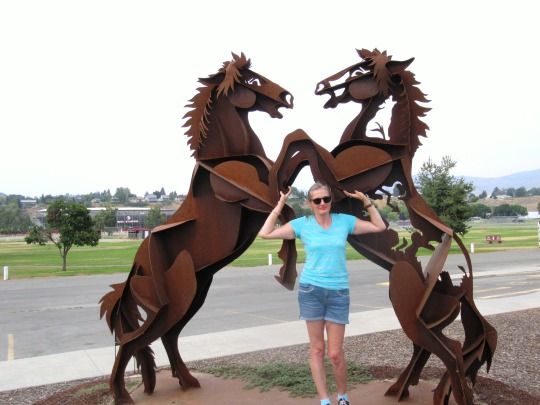

















Levi Strauss Day
They’re comfy. They last for years and years. They don’t require dry-cleaning or any other kind of special treatment. They’re perfect for a number of occasions, from a trip to the grocery store, to a walk in the park, to an evening at the pub, to a number of even semi-formal social occasions. They’re incredibly versatile, meaning they look good with pretty much everything, from t-shirts to smart blazers. In fact, you can’t imagine life without them at all.
What are we talking about? Jeans, of course! This iconic garment is more than deserving of it own holiday, as is Mr. Levi Strauss, a man without whom jeans as we know them might not exist at all.
“In the old days, people used to risk their lives in India or in the Americas in order to bring back products which now seem to us to have been of comically little worth” – Levi Strauss.
The History of Levi Strauss Day
Levi Strauss was a German-American businessman born in Bavaria on February 26th, 1829, who came to the United States with his family the mid-1800s when he was 18 years old. Strauss began as a dry goods wholesaler in San Francisco, California, where he sold various items such as clothing, bedding, bags and handkerchiefs to settlers, many of whom had arrived in California to take part in the gold rush. Needless to say, the hard physical labor required of the miners of the day and those building new railroads made it difficult for them to find clothing that would last for more than a few months without falling apart at the seams. One day in 1870, one of Strauss’ clients, a tailor named Jacob W. Davis was approached by a woman who needed a pair of exceptionally strong working pants for her husband, a woodcutter. Her request prompted Davis to make a pair of pants from the denim he’d bought at Strauss’ shop that he then strengthened with copper rivets to reinforce the stitching. Word of the new article of clothing and its endurance spread fast, and soon Davis was not able to keep up with the demand for his invention, nor did he have the resources to open a larger tailor shop or obtain a patent. Falling further and further behind and afraid someone else would steal his idea, Davis decided to ask for Strauss’ financial backing in the filing of a patent application. Strauss agreed, the patent was issued, the two men became business partners, and Levi Strauss & Co was born.
How to Celebrate Levi Strauss Day
Levi Strauss’ story is considered to be the quintessence of the “American Dream”, a belief that all men and women were created equal and that hard work, ambition and creativity are all that is needed to become successful, both financially and otherwise. Levi Strauss’ family was anything but wealthy, with his father making just enough money as a peddler to keep the family afloat until he died of tuberculosis, a tragedy that plunged the Strauss family into poverty. Regardless of any and all setbacks, however, Levi Strauss managed to make an enormous amount of money. Strauss was not the stereotype of a stingy, rich miser, however–far from it. Throughout his life, he made numerous donations to various orphanages and other charity organizations. That’s why a great way to celebrate this day would be to read the biography of Levi Strauss or any other man or woman who has achieved success through hard work and dedication, and then used his or her money and influences to help others.
Source
#summer 2023#USA#Canada#Yukon#British Columbia#Alberta#Washington#Oregon#California#travel#yes all of them are Levi's jeans shorts#Levi's is my favorite jeans brand#vacation#landscape#cityscape#HQ#headquarters#Levi Strauss Day#LeviStraussDay#26 February 1829#195th birthday#Levi Strauss#195th anniversary#born#US history#Austrian history#San Francisco#Levi's Plaza
0 notes
Photo










Levi Strauss Day
They’re comfy. They last for years and years. They don’t require dry-cleaning or any other kind of special treatment. They’re perfect for a number of occasions, from a trip to the grocery store, to a walk in the park, to an evening at the pub, to a number of even semi-formal social occasions. They’re incredibly versatile, meaning they look good with pretty much everything, from t-shirts to smart blazers. In fact, you can’t imagine life without them at all.
What are we talking about? Jeans, of course! This iconic garment is more than deserving of it own holiday, as is Mr. Levi Strauss, a man without whom jeans as we know them might not exist at all.
“In the old days, people used to risk their lives in India or in the Americas in order to bring back products which now seem to us to have been of comically little worth” – Levi Strauss.
The History of Levi Strauss Day
Levi Strauss was a German-American businessman born in Bavaria on February 26th, 1829, who came to the United States with his family the mid-1800s when he was 18 years old. Strauss began as a dry goods wholesaler in San Francisco, California, where he sold various items such as clothing, bedding, bags and handkerchiefs to settlers, many of whom had arrived in California to take part in the gold rush. Needless to say, the hard physical labor required of the miners of the day and those building new railroads made it difficult for them to find clothing that would last for more than a few months without falling apart at the seams. One day in 1870, one of Strauss’ clients, a tailor named Jacob W. Davis was approached by a woman who needed a pair of exceptionally strong working pants for her husband, a woodcutter. Her request prompted Davis to make a pair of pants from the denim he’d bought at Strauss’ shop that he then strengthened with copper rivets to reinforce the stitching. Word of the new article of clothing and its endurance spread fast, and soon Davis was not able to keep up with the demand for his invention, nor did he have the resources to open a larger tailor shop or obtain a patent. Falling further and further behind and afraid someone else would steal his idea, Davis decided to ask for Strauss’ financial backing in the filing of a patent application. Strauss agreed, the patent was issued, the two men became business partners, and Levi Strauss & Co was born.
How to Celebrate Levi Strauss Day
Levi Strauss’ story is considered to be the quintessence of the “American Dream”, a belief that all men and women were created equal and that hard work, ambition and creativity are all that is needed to become successful, both financially and otherwise. Levi Strauss’ family was anything but wealthy, with his father making just enough money as a peddler to keep the family afloat until he died of tuberculosis, a tragedy that plunged the Strauss family into poverty. Regardless of any and all setbacks, however, Levi Strauss managed to make an enormous amount of money. Strauss was not the stereotype of a stingy, rich miser, however–far from it. Throughout his life, he made numerous donations to various orphanages and other charity organizations. That’s why a great way to celebrate this day would be to read the biography of Levi Strauss or any other man or woman who has achieved success through hard work and dedication, and then used his or her money and influences to help others.
Source
#Levi Strauss Day#LeviStraussDay#born#birthday#26 February 1829#anniversary#history#clothes#jeans#my favorite jeans' brand is Levi's#original photography#summer vacation#travel#Napa#Lyman Rest Stop#Echo Reservoir#DeWitt#logo#San Francisco#HQ#Levi Strauss & Co#shorts#Lusk#Santa Barbara#USA
1 note
·
View note
Photo










Levi Strauss Day
They’re comfy. They last for years and years. They don’t require dry-cleaning or any other kind of special treatment. They’re perfect for a number of occasions, from a trip to the grocery store, to a walk in the park, to an evening at the pub, to a number of even semi-formal social occasions. They’re incredibly versatile, meaning they look good with pretty much everything, from t-shirts to smart blazers. In fact, you can’t imagine life without them at all.
What are we talking about? Jeans, of course! This iconic garment is more than deserving of it own holiday, as is Mr. Levi Strauss, a man without whom jeans as we know them might not exist at all.
“In the old days, people used to risk their lives in India or in the Americas in order to bring back products which now seem to us to have been of comically little worth” – Levi Strauss.
The History of Levi Strauss Day
Levi Strauss was a German-American businessman born in Bavaria on February 26th, 1829, who came to the United States with his family the mid-1800s when he was 18 years old. Strauss began as a dry goods wholesaler in San Francisco, California, where he sold various items such as clothing, bedding, bags and handkerchiefs to settlers, many of whom had arrived in California to take part in the gold rush. Needless to say, the hard physical labor required of the miners of the day and those building new railroads made it difficult for them to find clothing that would last for more than a few months without falling apart at the seams. One day in 1870, one of Strauss’ clients, a tailor named Jacob W. Davis was approached by a woman who needed a pair of exceptionally strong working pants for her husband, a woodcutter. Her request prompted Davis to make a pair of pants from the denim he’d bought at Strauss’ shop that he then strengthened with copper rivets to reinforce the stitching. Word of the new article of clothing and its endurance spread fast, and soon Davis was not able to keep up with the demand for his invention, nor did he have the resources to open a larger tailor shop or obtain a patent. Falling further and further behind and afraid someone else would steal his idea, Davis decided to ask for Strauss’ financial backing in the filing of a patent application. Strauss agreed, the patent was issued, the two men became business partners, and Levi Strauss & Co was born.
How to Celebrate Levi Strauss Day
Levi Strauss’ story is considered to be the quintessence of the “American Dream”, a belief that all men and women were created equal and that hard work, ambition and creativity are all that is needed to become successful, both financially and otherwise. Levi Strauss’ family was anything but wealthy, with his father making just enough money as a peddler to keep the family afloat until he died of tuberculosis, a tragedy that plunged the Strauss family into poverty. Regardless of any and all setbacks, however, Levi Strauss managed to make an enormous amount of money. Strauss was not the stereotype of a stingy, rich miser, however–far from it. Throughout his life, he made numerous donations to various orphanages and other charity organizations. That’s why a great way to celebrate this day would be to read the biography of Levi Strauss or any other man or woman who has achieved success through hard work and dedication, and then used his or her money and influences to help others.
Source
#Levi Strauss & Co. HQ#Levi Strauss Day#LeviStraussDay#Levi Strauss#26 February 1829#born#birthday#my favorite jeans brand#Pont du Gard#France#USA#original photography#travel#vacation#San Francisco#California#architecture#cityscape#Sweden#Sverige#Echo Reservoir#Wyoming#landscape#Öland#Robert Mondavi Winery#Napa Valley#Omaha#clothes#pants#26 February
1 note
·
View note
Photo










Levi Strauss Day
They’re comfy. They last for years and years. They don’t require dry-cleaning or any other kind of special treatment. They’re perfect for a number of occasions, from a trip to the grocery store, to a walk in the park, to an evening at the pub, to a number of even semi-formal social occasions. They’re incredibly versatile, meaning they look good with pretty much everything, from t-shirts to smart blazers. In fact, you can’t imagine life without them at all.
What are we talking about? Jeans, of course! This iconic garment is more than deserving of it own holiday, as is Mr. Levi Strauss, a man without whom jeans as we know them might not exist at all.
“In the old days, people used to risk their lives in India or in the Americas in order to bring back products which now seem to us to have been of comically little worth” – Levi Strauss.
The History of Levi Strauss Day
Levi Strauss was a German-American businessman born in Bavaria on February 26th, 1829, who came to the United States with his family the mid-1800s when he was 18 years old. Strauss began as a dry goods wholesaler in San Francisco, California, where he sold various items such as clothing, bedding, bags and handkerchiefs to settlers, many of whom had arrived in California to take part in the gold rush. Needless to say, the hard physical labor required of the miners of the day and those building new railroads made it difficult for them to find clothing that would last for more than a few months without falling apart at the seams. One day in 1870, one of Strauss’ clients, a tailor named Jacob W. Davis was approached by a woman who needed a pair of exceptionally strong working pants for her husband, a woodcutter. Her request prompted Davis to make a pair of pants from the denim he’d bought at Strauss’ shop that he then strengthened with copper rivets to reinforce the stitching. Word of the new article of clothing and its endurance spread fast, and soon Davis was not able to keep up with the demand for his invention, nor did he have the resources to open a larger tailor shop or obtain a patent. Falling further and further behind and afraid someone else would steal his idea, Davis decided to ask for Strauss’ financial backing in the filing of a patent application. Strauss agreed, the patent was issued, the two men became business partners, and Levi Strauss & Co was born.
How to Celebrate Levi Strauss Day
Levi Strauss’ story is considered to be the quintessence of the “American Dream”, a belief that all men and women were created equal and that hard work, ambition and creativity are all that is needed to become successful, both financially and otherwise. Levi Strauss’ family was anything but wealthy, with his father making just enough money as a peddler to keep the family afloat until he died of tuberculosis, a tragedy that plunged the Strauss family into poverty. Regardless of any and all setbacks, however, Levi Strauss managed to make an enormous amount of money. Strauss was not the stereotype of a stingy, rich miser, however–far from it. Throughout his life, he made numerous donations to various orphanages and other charity organizations. That’s why a great way to celebrate this day would be to read the biography of Levi Strauss or any other man or woman who has achieved success through hard work and dedication, and then used his or her money and influences to help others.
Source
#Levi Strauss Day#26 February 1829#anniversary#birthday#born#travel#Levi Strauss#my favorite jeans' brand is Levi's#Levi's#HQ#San Francisco#California#summer 2017#architecture#cityscape#tourist attraction#USA#landmark#original photography#Blue Jeans#DeWitt#Lyman#Omaha#Robert Mondavi Winery#Echo Reservoir#Lusk#2019#landscape#LeviStraussDay
0 notes
Photo










They’re comfy. They last for years and years. They don’t require dry-cleaning or any other kind of special treatment. They’re perfect for a number of occasions, from a trip to the grocery store, to a walk in the park, to an evening at the pub, to a number of even semi-formal social occasions. They’re incredibly versatile, meaning they look good with pretty much everything, from t-shirts to smart blazers. In fact, you can’t imagine life without them at all.
What are we talking about? Jeans, of course! This iconic garment is more than deserving of it own holiday, as is Mr. Levi Strauss, a man without whom jeans as we know them might not exist at all.
“In the old days, people used to risk their lives in India or in the Americas in order to bring back products which now seem to us to have been of comically little worth” – Levi Strauss.
The History of Levi Strauss Day
Levi Strauss was a German-American businessman born in Bavaria on February 26th, 1829, who came to the United States with his family the mid-1800s when he was 18 years old. Strauss began as a dry goods wholesaler in San Francisco, California, where he sold various items such as clothing, bedding, bags and handkerchiefs to settlers, many of whom had arrived in California to take part in the gold rush. Needless to say, the hard physical labor required of the miners of the day and those building new railroads made it difficult for them to find clothing that would last for more than a few months without falling apart at the seams. One day in 1870, one of Strauss’ clients, a tailor named Jacob W. Davis was approached by a woman who needed a pair of exceptionally strong working pants for her husband, a woodcutter. Her request prompted Davis to make a pair of pants from the denim he’d bought at Strauss’ shop that he then strengthened with copper rivets to reinforce the stitching. Word of the new article of clothing and its endurance spread fast, and soon Davis was not able to keep up with the demand for his invention, nor did he have the resources to open a larger tailor shop or obtain a patent. Falling further and further behind and afraid someone else would steal his idea, Davis decided to ask for Strauss’ financial backing in the filing of a patent application. Strauss agreed, the patent was issued, the two men became business partners, and Levi Strauss & Co was born.
How to Celebrate Levi Strauss Day
Levi Strauss’ story is considered to be the quintessence of the “American Dream”, a belief that all men and women were created equal and that hard work, ambition and creativity are all that is needed to become successful, both financially and otherwise. Levi Strauss’ family was anything but wealthy, with his father making just enough money as a peddler to keep the family afloat until he died of tuberculosis, a tragedy that plunged the Strauss family into poverty. Regardless of any and all setbacks, however, Levi Strauss managed to make an enormous amount of money. Strauss was not the stereotype of a stingy, rich miser, however–far from it. Throughout his life, he made numerous donations to various orphanages and other charity organizations. That’s why a great way to celebrate this day would be to read the biography of Levi Strauss or any other man or woman who has achieved success through hard work and dedication, and then used his or her money and influences to help others.
Source
#Levi Strauss Day#birth#26 February 1829#anniversary#history#culture#clothing#national day#San Francisco#original photography#summer 2017#red housemark batwing#Walter Landor#Levis Plaza#jeans#Levi's#my favorite brand of jeans#usa#canada#summer 2018#cityscape#landscape#and yes these are all levi's shorts#boots#hotel room#interior
0 notes
Photo










They’re comfy. They last for years and years. They don’t require dry-cleaning or any other kind of special treatment. They’re perfect for a number of occasions, from a trip to the grocery store, to a walk in the park, to an evening at the pub, to a number of even semi-formal social occasions. They’re incredibly versatile, meaning they look good with pretty much everything, from t-shirts to smart blazers. In fact, you can’t imagine life without them at all.
What are we talking about? Jeans, of course! This iconic garment is more than deserving of it own holiday, as is Mr. Levi Strauss, a man without whom jeans as we know them might not exist at all.
“In the old days, people used to risk their lives in India or in the Americas in order to bring back products which now seem to us to have been of comically little worth” – Levi Strauss.
The History of Levi Strauss Day
Levi Strauss was a German-American businessman born in Bavaria on February 26th, 1829, who came to the United States with his family the mid-1800s when he was 18 years old. Strauss began as a dry goods wholesaler in San Francisco, California, where he sold various items such as clothing, bedding, bags and handkerchiefs to settlers, many of whom had arrived in California to take part in the gold rush. Needless to say, the hard physical labor required of the miners of the day and those building new railroads made it difficult for them to find clothing that would last for more than a few months without falling apart at the seams. One day in 1870, one of Strauss’ clients, a tailor named Jacob W. Davis was approached by a woman who needed a pair of exceptionally strong working pants for her husband, a woodcutter. Her request prompted Davis to make a pair of pants from the denim he’d bought at Strauss’ shop that he then strengthened with copper rivets to reinforce the stitching. Word of the new article of clothing and its endurance spread fast, and soon Davis was not able to keep up with the demand for his invention, nor did he have the resources to open a larger tailor shop or obtain a patent. Falling further and further behind and afraid someone else would steal his idea, Davis decided to ask for Strauss’ financial backing in the filing of a patent application. Strauss agreed, the patent was issued, the two men became business partners, and Levi Strauss & Co was born.
How to Celebrate Levi Strauss Day
Levi Strauss’ story is considered to be the quintessence of the “American Dream”, a belief that all men and women were created equal and that hard work, ambition and creativity are all that is needed to become successful, both financially and otherwise. Levi Strauss’ family was anything but wealthy, with his father making just enough money as a peddler to keep the family afloat until he died of tuberculosis, a tragedy that plunged the Strauss family into poverty. Regardless of any and all setbacks, however, Levi Strauss managed to make an enormous amount of money. Strauss was not the stereotype of a stingy, rich miser, however–far from it. Throughout his life, he made numerous donations to various orphanages and other charity organizations. That’s why a great way to celebrate this day would be to read the biography of Levi Strauss or any other man or woman who has achieved success through hard work and dedication, and then used his or her money and influences to help others.
Source
#Levi Strauss Day#LeviStraussDay#26 February#national day#batwing#Levi Strauss#Levi Strauss & Co. HQ#old jeans#San Francisco#hotel#travel#summer#my favoirte jeans brand#cowoboy boots#shorts#interior#west coast#pacific ocean#cityscape#landscape#countryside#exterior#museum#Petrified Forest National Park#Painted Desert#beach#santa barbara#cowboy hat#fashion#vacation
0 notes